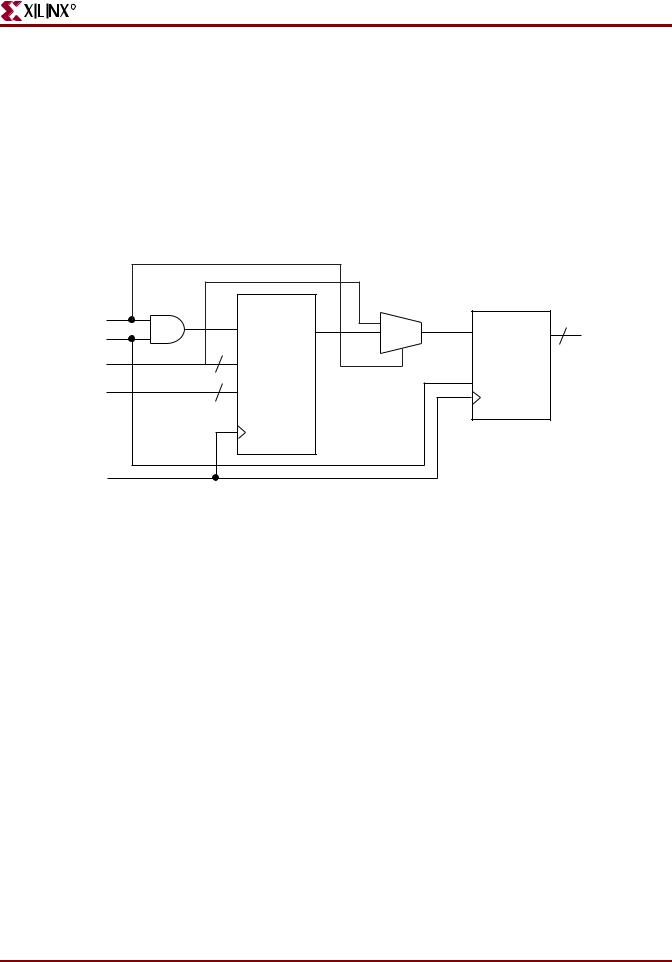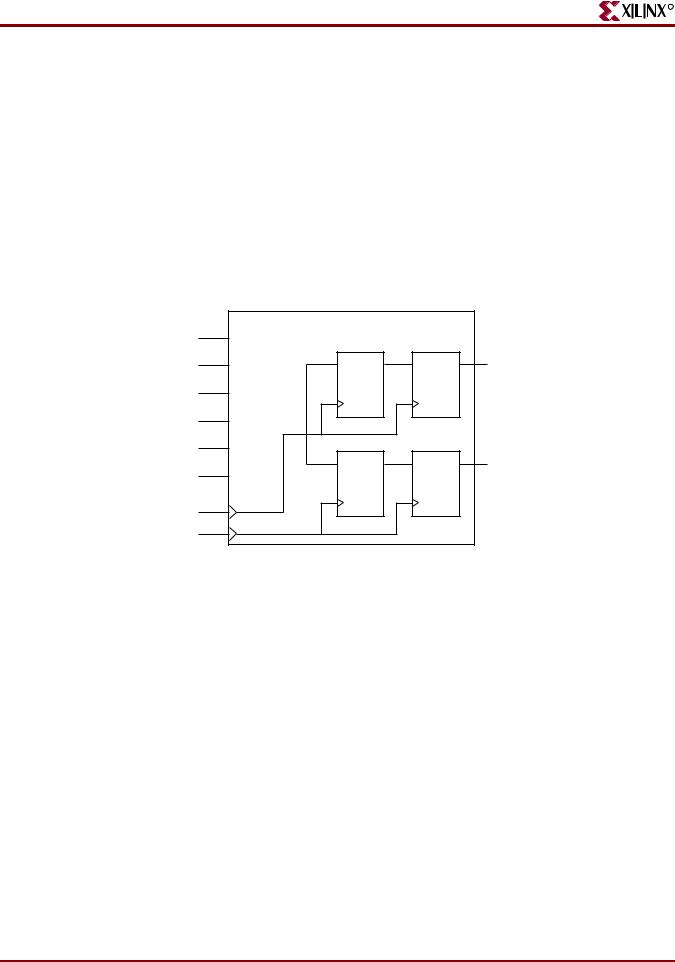
- •XST User Guide
- •Table of Contents
- •About the XST User Guide
- •XST User Guide Contents
- •Additional Resources
- •Conventions
- •Typographical
- •Online Document
- •1 Introduction to the XST User Guide
- •About XST
- •What’s New in Release 10.1
- •Macro Inference
- •Constraints
- •Libraries Support
- •Setting XST Options
- •2 XST HDL Coding Techniques
- •Signed and Unsigned Support in XST
- •Registers HDL Coding Techniques
- •About Registers
- •Registers Log File
- •Registers Related Constraints
- •Registers Coding Examples
- •Latches HDL Coding Techniques
- •About Latches
- •Latches Log File
- •Latches Related Constraints
- •Latches Coding Examples
- •Tristates HDL Coding Techniques
- •About Tristates
- •Tristates Log File
- •Tristates Related Constraints
- •Tristates Coding Examples
- •Counters HDL Coding Techniques
- •About Counters
- •Counters Log File
- •Counters Related Constraints
- •Counters Coding Examples
- •Accumulators HDL Coding Techniques
- •About Accumulators
- •Accumulators in Virtex-4 and Virtex-5 Devices
- •Accumulators Log File
- •Accumulators Related Constraints
- •Accumulators Coding Examples
- •Shift Registers HDL Coding Techniques
- •About Shift Registers
- •Describing Shift Registers
- •Implementing Shift Registers
- •Shift Registers Log File
- •Shift Registers Related Constraints
- •Shift Registers Coding Examples
- •Dynamic Shift Registers HDL Coding Techniques
- •About Dynamic Shift Registers
- •Dynamic Shift Registers Log File
- •Dynamic Shift Registers Related Constraints
- •Dynamic Shift Registers Coding Examples
- •Multiplexers HDL Coding Techniques
- •About Multiplexers
- •Multiplexers Case Statements
- •Multiplexers Log File
- •Multiplexers Related Constraints
- •Multiplexers Coding Examples
- •Decoders HDL Coding Techniques
- •About Decoders
- •Decoders Log File
- •Decoders Related Constraints
- •Decoders Coding Examples
- •Priority Encoders HDL Coding Techniques
- •About Priority Encoders
- •Priority Encoders Log File
- •Priority Encoders Related Constraints
- •Priority Encoders Coding Examples
- •Logical Shifters HDL Coding Techniques
- •About Logical Shifters
- •Logical Shifters Log File
- •Logical Shifters Related Constraints
- •Logical Shifters Coding Examples
- •Arithmetic Operators HDL Coding Techniques
- •About Arithmetic Operators
- •Arithmetic Operators Log File
- •Arithmetic Operators Related Constraints
- •Arithmetic Operators Coding Examples
- •About Adders, Subtractors, and Adders/Subtractors
- •Adders, Subtractors, and Adders/Subtractors Log File
- •Adders, Subtractors, and Adders/Subtractors Related Constraints
- •Adders, Subtractors, and Adders/Subtractors Coding Examples
- •Comparators HDL Coding Techniques
- •About Comparators
- •Comparators Log File
- •Comparators Related Constraints
- •Comparators Coding Examples
- •Multipliers HDL Coding Techniques
- •About Multipliers
- •Large Multipliers Using Block Multipliers
- •Registered Multipliers
- •Multipliers (Virtex-4, Virtex-5, and Spartan-3A D Devices)
- •Multiplication with Constant
- •Multipliers Log File
- •Multipliers Related Constraints
- •Multipliers Coding Examples
- •Sequential Complex Multipliers HDL Coding Techniques
- •About Sequential Complex Multipliers
- •Sequential Complex Multipliers Log File
- •Sequential Complex Multipliers Related Constraints
- •Sequential Complex Multipliers Coding Examples
- •Pipelined Multipliers HDL Coding Techniques
- •About Pipelined Multipliers
- •Pipelined Multipliers Log File
- •Pipelined Multipliers Related Constraints
- •Pipelined Multipliers Coding Examples
- •Multiply Adder/Subtractors HDL Coding Techniques
- •About Multiply Adder/Subtractors
- •Multiply Adder/Subtractors in Virtex-4 and Virtex- 5 Devices
- •Multiply Adder/Subtractors Log File
- •Multiply Adder/Subtractors Related Constraints
- •Multiply Adder/Subtractors Coding Examples
- •Multiply Accumulate HDL Coding Techniques
- •About Multiply Accumulate
- •Multiply Accumulate in Virtex-4 and Virtex-5 Devices
- •Multiply Accumulate Log File
- •Multiply Accumulate Related Constraints
- •Multiply Accumulate Coding Examples
- •Dividers HDL Coding Techniques
- •About Dividers
- •Dividers Log File
- •Dividers Related Constraints
- •Dividers Coding Examples
- •Resource Sharing HDL Coding Techniques
- •About Resource Sharing
- •Resource Sharing Log File
- •Resource Sharing Related Constraints
- •Resource Sharing Coding Examples
- •RAMs and ROMs HDL Coding Techniques
- •About RAMs and ROMs
- •RAMs and ROMs Log File
- •RAMs and ROMs Related Constraints
- •RAMs and ROMs Coding Examples
- •Initializing RAM Coding Examples
- •ROMs Using Block RAM Resources HDL Coding Techniques
- •About ROMs Using Block RAM Resources
- •ROMs Using Block RAM Resources Log File
- •ROMs Using Block RAM Resources Related Constraints
- •ROMs Using Block RAM Resources Coding Examples
- •Pipelined Distributed RAM HDL Coding Techniques
- •About Pipelined Distributed RAM
- •Pipelined Distributed RAM Log File
- •Pipelined Distributed RAM Related Constraints
- •Pipelined Distributed RAM Coding Examples
- •Finite State Machines (FSMs) HDL Coding Techniques
- •About Finite State Machines (FSMs)
- •Describing Finite State Machines (FSMs)
- •State Encoding Techniques
- •RAM-Based FSM Synthesis
- •Safe FSM Implementation
- •Finite State Machines Log File
- •Finite State Machines Related Constraints
- •Finite State Machines Coding Examples
- •Black Boxes HDL Coding Techniques
- •About Black Boxes
- •Black Box Log File
- •Black Box Related Constraints
- •Black Box Coding Examples
- •3 XST FPGA Optimization
- •About XST FPGA Optimization
- •Virtex-Specific Synthesis Options
- •Macro Generation
- •Virtex Macro Generator
- •Arithmetic Functions in Macro Generation
- •Loadable Functions in Macro Generation
- •Multiplexers in Macro Generation
- •Priority Encoders in Macro Generation
- •Decoders in Macro Generation
- •Shift Registers in Macro Generation
- •RAMs in Macro Generation
- •ROMs in Macro Generation
- •DSP48 Block Resources
- •Mapping Logic Onto Block RAM
- •About Mapping Logic Onto Block RAM
- •Mapping Logic Onto Block RAM Log Files
- •Mapping Logic Onto Block RAM Coding Examples
- •Flip-Flop Retiming
- •About Flip-Flop Retiming
- •Limitations of Flip-Flop Retiming
- •Controlling Flip-Flop Retiming
- •Partitions
- •Incremental Synthesis
- •About Incremental Synthesis
- •Incremental Synthesis (INCREMENTAL_SYNTHESIS)
- •Grouping Through Incremental Synthesis Diagram
- •Resynthesize (RESYNTHESIZE)
- •Speed Optimization Under Area Constraint
- •About Speed Optimization Under Area Constraint
- •Speed Optimization Under Area Constraint Examples
- •FPGA Optimization Log File
- •Design Optimization Report
- •Cell Usage Report
- •Timing Report
- •Implementation Constraints
- •Virtex Primitive Support
- •Instantiating Virtex Primitives
- •Generating Primitives Through Attributes
- •Primitives and Black Boxes
- •VHDL and Verilog Virtex Libraries
- •Virtex Primitives Log File
- •Virtex Primitives Related Constraints
- •Virtex Primitives Coding Examples
- •Using the UNIMACRO Library
- •Cores Processing
- •Specifying INIT and RLOC
- •About Specifying INIT and RLOC
- •Passing an INIT Value Via the LUT_MAP Constraint Coding Examples
- •Specifying INIT Value for a Flip-Flop Coding Examples
- •Specifying INIT and RLOC Values for a Flip-Flop Coding Examples
- •Using PCI Flow With XST
- •Satisfying Placement Constraints and Meeting Timing Requirements
- •Preventing Logic and Flip-Flop Replication
- •Disabling Read Cores
- •4 XST CPLD Optimization
- •CPLD Synthesis Options
- •About CPLD Synthesis Options
- •CPLD Synthesis Supported Devices
- •Setting CPLD Synthesis Options
- •Implementation Details for Macro Generation
- •CPLD Synthesis Log File Analysis
- •CPLD Synthesis Constraints
- •Improving Results in CPLD Synthesis
- •About Improving Results in CPLD Synthesis
- •Obtaining Better Frequency
- •Fitting a Large Design
- •5 XST Design Constraints
- •About Constraints
- •List of XST Design Constraints
- •XST General Constraints
- •XST HDL Constraints
- •XST FPGA Constraints (Non-Timing)
- •XST CPLD Constraints (Non-Timing)
- •XST Timing Constraints
- •XST Implementation Constraints
- •Third Party Constraints
- •Setting Global Constraints and Options
- •Setting Synthesis Options
- •Setting HDL Options
- •Setting Xilinx-Specific Options
- •Setting Other XST Command Line Options
- •Custom Compile File List
- •VHDL Attribute Syntax
- •Verilog-2001 Attributes
- •About Verilog-2001 Attributes
- •Verilog-2001 Attributes Syntax
- •Verilog-2001 Limitations
- •Verilog-2001 Meta Comments
- •XST Constraint File (XCF)
- •Specifying the XST Constraint File (XCF)
- •XCF Syntax and Utilization
- •Native and Non-Native User Constraint File (UCF) Constraints Syntax
- •XCF Syntax Limitations
- •Constraints Priority
- •XST-Specific Non-Timing Options
- •XST Command Line Only Options
- •XST Timing Options
- •XST Timing Options: Project Navigator > Process Properties or Command Line
- •XST Timing Options: Xilinx Constraint File (XCF)
- •XST General Constraints
- •Add I/O Buffers (–iobuf)
- •BoxType (BOX_TYPE)
- •Bus Delimiter (–bus_delimiter)
- •Case (–case)
- •Case Implementation Style (–vlgcase)
- •Verilog Macros (-define)
- •Duplication Suffix (–duplication_suffix)
- •Full Case (FULL_CASE)
- •Generate RTL Schematic (–rtlview)
- •Generics (-generics)
- •Hierarchy Separator (–hierarchy_separator)
- •I/O Standard (IOSTANDARD)
- •Keep (KEEP)
- •Keep Hierarchy (KEEP_HIERARCHY)
- •Library Search Order (–lso)
- •Netlist Hierarchy (-netlist_hierarchy)
- •Optimization Effort (OPT_LEVEL)
- •Optimization Goal (OPT_MODE)
- •Parallel Case (PARALLEL_CASE)
- •RLOC
- •Save (S / SAVE)
- •Synthesis Constraint File (–uc)
- •Use Synthesis Constraints File (–iuc)
- •Verilog Include Directories (–vlgincdir)
- •Verilog 2001 (–verilog2001)
- •HDL Library Mapping File (–xsthdpini)
- •Work Directory (–xsthdpdir)
- •XST HDL Constraints
- •About XST HDL Constraints
- •Automatic FSM Extraction (FSM_EXTRACT)
- •Enumerated Encoding (ENUM_ENCODING)
- •Equivalent Register Removal (EQUIVALENT_REGISTER_REMOVAL)
- •FSM Encoding Algorithm (FSM_ENCODING)
- •Mux Extraction (MUX_EXTRACT)
- •Register Power Up (REGISTER_POWERUP)
- •Resource Sharing (RESOURCE_SHARING)
- •Safe Recovery State (SAFE_RECOVERY_STATE)
- •Safe Implementation (SAFE_IMPLEMENTATION)
- •Signal Encoding (SIGNAL_ENCODING)
- •XST FPGA Constraints (Non-Timing)
- •Asynchronous to Synchronous (ASYNC_TO_SYNC)
- •Automatic BRAM Packing (AUTO_BRAM_PACKING)
- •BRAM Utilization Ratio (BRAM_UTILIZATION_RATIO)
- •Buffer Type (BUFFER_TYPE)
- •Extract BUFGCE (BUFGCE)
- •Cores Search Directories (–sd)
- •Decoder Extraction (DECODER_EXTRACT)
- •DSP Utilization Ratio (DSP_UTILIZATION_RATIO)
- •FSM Style (FSM_STYLE)
- •Power Reduction (POWER)
- •Read Cores (READ_CORES)
- •Resynthesize (RESYNTHESIZE)
- •Incremental Synthesis (INCREMENTAL_SYNTHESIS)
- •Logical Shifter Extraction (SHIFT_EXTRACT)
- •LUT Combining (LC)
- •Map Logic on BRAM (BRAM_MAP)
- •Max Fanout (MAX_FANOUT)
- •Move First Stage (MOVE_FIRST_STAGE)
- •Move Last Stage (MOVE_LAST_STAGE)
- •Multiplier Style (MULT_STYLE)
- •Mux Style (MUX_STYLE)
- •Number of Global Clock Buffers (–bufg)
- •Number of Regional Clock Buffers (–bufr)
- •Optimize Instantiated Primitives (OPTIMIZE_PRIMITIVES)
- •Pack I/O Registers Into IOBs (IOB)
- •Priority Encoder Extraction (PRIORITY_EXTRACT)
- •RAM Extraction (RAM_EXTRACT)
- •RAM Style (RAM_STYLE)
- •Reduce Control Sets (REDUCE_CONTROL_SETS)
- •Register Balancing (REGISTER_BALANCING)
- •Register Duplication (REGISTER_DUPLICATION)
- •ROM Extraction (ROM_EXTRACT)
- •ROM Style (ROM_STYLE)
- •Shift Register Extraction (SHREG_EXTRACT)
- •Slice Packing (–slice_packing)
- •Use Low Skew Lines (USELOWSKEWLINES)
- •XOR Collapsing (XOR_COLLAPSE)
- •Slice (LUT-FF Pairs) Utilization Ratio (SLICE_UTILIZATION_RATIO)
- •Map Entity on a Single LUT (LUT_MAP)
- •Use Carry Chain (USE_CARRY_CHAIN)
- •Convert Tristates to Logic (TRISTATE2LOGIC)
- •Use Clock Enable (USE_CLOCK_ENABLE)
- •Use Synchronous Set (USE_SYNC_SET)
- •Use Synchronous Reset (USE_SYNC_RESET)
- •XST CPLD Constraints (Non-Timing)
- •Clock Enable (–pld_ce)
- •Data Gate (DATA_GATE)
- •Macro Preserve (–pld_mp)
- •No Reduce (NOREDUCE)
- •WYSIWYG (–wysiwyg)
- •XOR Preserve (–pld_xp)
- •XST Timing Constraints
- •Applying Timing Constraints
- •Cross Clock Analysis (–cross_clock_analysis)
- •Write Timing Constraints (–write_timing_constraints)
- •Clock Signal (CLOCK_SIGNAL)
- •Global Optimization Goal (–glob_opt)
- •XCF Timing Constraint Support
- •Period (PERIOD)
- •Offset (OFFSET)
- •From-To (FROM-TO)
- •Timing Name (TNM)
- •Timing Name on a Net (TNM_NET)
- •Timegroup (TIMEGRP)
- •Timing Ignore (TIG)
- •XST Implementation Constraints
- •About Implementation Constraints
- •Implementation Constraints Syntax Examples
- •RLOC
- •NOREDUCE
- •PWR_MODE
- •XST-Supported Third Party Constraints
- •XST Equivalents to Third Party Constraints
- •Third Party Constraints Syntax Examples
- •6 XST VHDL Language Support
- •About XST VHDL Language Support
- •VHDL IEEE Support
- •About VHDL IEEE Support
- •VHDL IEEE Conflicts
- •Non-LRM Compliant Constructs in VHDL
- •XST VHDL File Type Support
- •About XST VHDL File Type Support
- •XST VHDL File Type Support Table
- •Debugging Using Write Operation in VHDL
- •Rules for Debugging Using Write Operation in VHDL
- •VHDL Data Types
- •Accepted VHDL Data Types
- •VHDL Overloaded Data Types
- •VHDL Multi-Dimensional Array Types
- •VHDL Record Types
- •VHDL Initial Values
- •About VHDL Initial Values
- •VHDL Local Reset/Global Reset
- •Default Initial Values on Memory Elements in VHDL
- •VHDL Objects
- •Signals in VHDL
- •Variables in VHDL
- •Constants in VHDL
- •VHDL Operators
- •Entity and Architecture Descriptions in VHDL
- •VHDL Circuit Descriptions
- •VHDL Entity Declarations
- •VHDL Architecture Declarations
- •VHDL Component Instantiation
- •VHDL Recursive Component Instantiation
- •VHDL Component Configuration
- •VHDL Generic Parameter Declarations
- •VHDL Generic and Attribute Conflicts
- •VHDL Combinatorial Circuits
- •VHDL Concurrent Signal Assignments
- •VHDL Generate Statements
- •VHDL Combinatorial Processes
- •VHDL If...Else Statements
- •VHDL Case Statements
- •VHDL For...Loop Statements
- •VHDL Sequential Circuits
- •About VHDL Sequential Circuits
- •VHDL Sequential Process With a Sensitivity List
- •VHDL Sequential Process Without a Sensitivity List
- •Register and Counter Descriptions VHDL Coding Examples
- •VHDL Multiple Wait Statements Descriptions
- •VHDL Functions and Procedures
- •About VHDL Functions and Procedures
- •VHDL Functions and Procedures Examples
- •VHDL Assert Statements
- •About VHDL Assert Statements
- •SINGLE_SRL Describing a Shift Register
- •Using Packages to Define VHDL Models
- •About Using Packages to Define VHDL Models
- •Using Standard Packages to Define VHDL Models
- •Using IEEE Packages to Define VHDL Models
- •Using Synopsys Packages to Define VHDL Models
- •VHDL Constructs Supported in XST
- •VHDL Design Entities and Configurations
- •VHDL Expressions
- •VHDL Statements
- •VHDL Reserved Words
- •7 XST Verilog Language Support
- •About XST Verilog Language Support
- •Behavioral Verilog
- •Variable Part Selects
- •Structural Verilog Features
- •About Structural Verilog Features
- •Structural Verilog Coding Examples
- •Verilog Parameters
- •Verilog Parameter and Attribute Conflicts
- •About Verilog Parameter and Attribute Conflicts
- •Verilog Parameter and Attribute Conflicts Precedence
- •Verilog Limitations in XST
- •Verilog Case Sensitivity
- •Verilog Blocking and Nonblocking Assignments
- •Verilog Integer Handling
- •Verilog Attributes and Meta Comments
- •About Verilog Attributes and Meta Comments
- •Verilog-2001 Attributes
- •Verilog Meta Comments
- •Verilog Constructs Supported in XST
- •Verilog Constants Supported in XST
- •Verilog Data Types Supported in XST
- •Verilog Continuous Assignments Supported in XST
- •Verilog Procedural Assignments Supported in XST
- •Verilog Design Hierarchies Supported in XST
- •Verilog Compiler Directives Supported in XST
- •Verilog System Tasks and Functions Supported in XST
- •Verilog Primitives
- •Verilog Reserved Keywords
- •Verilog-2001 Support in XST
- •8 XST Behavioral Verilog Language Support
- •Behavioral Verilog Variable Declarations
- •About Behavioral Verilog Variable Declarations
- •Behavioral Verilog Variable Declarations Coding Examples
- •Behavioral Verilog Initial Values
- •About Behavioral Verilog Initial Values
- •Behavioral Verilog Initial Values Coding Examples
- •Behavioral Verilog Local Reset
- •About Behavioral Verilog Local Reset
- •Behavioral Verilog Local Reset Coding Examples
- •Behavioral Verilog Arrays
- •Behavioral Verilog Multi-Dimensional Arrays
- •About Behavioral Verilog Multi-Dimensional Arrays
- •Behavioral Verilog Multi-Dimensional Arrays Coding Examples
- •Behavioral Verilog Data Types
- •About Behavioral Verilog Data Types
- •Behavioral Verilog Data Types Coding Examples
- •Behavioral Verilog Legal Statements
- •Behavioral Verilog Expressions
- •About Behavioral Verilog Expressions
- •Operators Supported in Behavioral Verilog
- •Expressions Supported in Behavioral Verilog
- •Results of Evaluating Expressions in Behavioral Verilog
- •Behavioral Verilog Blocks
- •Behavioral Verilog Modules
- •Behavioral Verilog Module Declarations
- •About Behavioral Verilog Module Declarations
- •Behavioral Verilog Module Declaration Coding Examples
- •Behavioral Verilog Continuous Assignments
- •About Behavioral Verilog Continuous Assignments
- •Behavioral Verilog Continuous Assignments Coding Examples
- •Behavioral Verilog Procedural Assignments
- •About Behavioral Verilog Procedural Assignments
- •Behavioral Verilog Combinatorial Always Blocks
- •Behavioral Verilog If...Else Statement
- •Behavioral Verilog Case Statements
- •Behavioral Verilog For and Repeat Loops
- •Behavioral Verilog While Loops
- •Behavioral Verilog Sequential Always Blocks
- •Behavioral Verilog Assign and Deassign Statements
- •Behavioral Verilog Assignment Extension Past 32 Bits
- •Behavioral Verilog Tasks and Functions
- •Behavioral Verilog Recursive Tasks and Functions
- •Behavioral Verilog Constant Functions
- •Behavioral Verilog Blocking Versus Non-Blocking Procedural Assignments
- •Behavioral Verilog Constants
- •Behavioral Verilog Macros
- •Behavioral Verilog Include Files
- •Behavioral Verilog Comments
- •Behavioral Verilog Generate Statements
- •Behavioral Verilog Generate For Statements
- •Behavioral Verilog Generate If... else Statements
- •Behavioral Verilog Generate Case Statements
- •9 XST Mixed Language Support
- •About Mixed Language Support
- •Mixed Language Project Files
- •VHDL and Verilog Boundary Rules in Mixed Language Projects
- •Instantiating a Verilog Module in a VHDL Design
- •Instantiating a VHDL Design Unit in a Verilog Design
- •Port Mapping in Mixed Language Projects
- •VHDL in Verilog Port Mapping
- •Verilog in VHDL Port Mapping
- •VHDL in Mixed Language Port Mapping
- •Verilog in Mixed Language Port Mapping
- •Generics Support in Mixed Language Projects
- •Library Search Order (LSO) Files in Mixed Language Projects
- •About the Library Search Order (LSO) File
- •Specifying the Library Search Order (LSO) File in Project Navigator
- •Specifying the Library Search Order (LSO) File in the Command Line
- •Library Search Order (LSO) Rules
- •10 XST Log Files
- •XST FPGA Log File Contents
- •XST FPGA Log File Copyright Statement
- •XST FPGA Log File Table of Contents
- •XST FPGA Log File Synthesis Options Summary
- •XST FPGA Log File HDL Compilation
- •XST FPGA Log File Design Hierarchy Analyzer
- •XST FPGA Log File HDL Analysis
- •XST FPGA Log File HDL Synthesis Report
- •XST FPGA Log File Advanced HDL Synthesis Report
- •XST FPGA Log File Low Level Synthesis
- •XST FPGA Log File Partition Report
- •XST FPGA Log File Final Report
- •Reducing the Size of the XST Log File
- •Use Message Filtering
- •Use Quiet Mode
- •Use Silent Mode
- •Hide Specific Messages
- •Macros in XST Log Files
- •XST Log File Examples
- •11 XST Naming Conventions
- •XST Net Naming Conventions
- •XST Instance Naming Conventions
- •XST Name Generation Control
- •12 XST Command Line Mode
- •Running XST in Command Line Mode
- •XST File Types in Command Line Mode
- •Temporary Files in Command Line Mode
- •Names With Spaces in Command Line Mode
- •Launching XST in Command Line Mode
- •Launching XST in Command Line Mode Using the XST Shell
- •Launching XST in Command Line Mode Using a Script File
- •Setting Up an XST Script
- •Setting Up an XST Script Using the Run Command
- •Setting Up an XST Script Using the Set Command
- •Setting Up an XST Script Using the Elaborate Command
- •Synthesizing VHDL Designs Using Command Line Mode
- •Synthesizing VHDL Designs Using Command Line Mode (Example)
- •Running XST in Script Mode (VHDL)
- •Synthesizing Verilog Designs Using Command Line Mode
- •Synthesizing Verilog Designs Using Command Line Mode (Example)
- •Running XST in Script Mode (Verilog)
- •Synthesizing Mixed Designs Using Command Line Mode
- •Synthesizing Mixed Designs Using Command Line Mode (Example)
- •Running XST in Script Mode (Mixed Language)

R
RAMs and ROMs HDL Coding Techniques
=========================================================================
...
RAMs and ROMs Related Constraints
•“BRAM Utilization Ratio (BRAM_UTILIZATION_RATIO)”
•“Automatic BRAM Packing (AUTO_BRAM_PACKING)”
•“RAM Extraction (RAM_EXTRACT)”
•“RAM Style (RAM_STYLE)”
•“ROM Extraction (ROM_EXTRACT)”
•“ROM Style (ROM_STYLE)”
XST accepts LOC and “RLOC” constraints on inferred RAMs that can be implemented in a single block RAM primitive. The LOC and RLOC constraints are propagated to the NGC netlist.
RAMs and ROMs Coding Examples
The coding examples in this section are accurate as of the date of publication. Download updates from ftp://ftp.xilinx.com/pub/documentation/misc/examples_v9.zip
•“Single-Port RAM in Read-First Mode”
•“Single-Port RAM in Write-First Mode”
•“Single-Port RAM In No-Change Mode”
•“Single-Port RAM With Asynchronous Read”
•“Single-Port RAM With False Synchronous Read”
•“Single-Port RAM With False Synchronous Read and Reset on the Output”
•“Single-Port RAM With Synchronous Read (Read Through)”
•“Single-Port RAM With Enable”
•“Dual-Port RAM With Asynchronous Read”
•“Dual-Port RAM With False Synchronous Read”
•“Dual-Port RAM With Synchronous Read (Read Through)”
•“Dual-Port RAM With Synchronous Read (Read Through) and Two Clocks”
•“Dual-Port RAM With One Enable Controlling Both Ports”
•“Dual Port RAM With Enable on Each Port”
•“Dual-Port Block RAM With Different Clocks”
•“Dual-Port Block RAM With Two Write Ports”
•“Block Ram with Byte-Wide Write Enable”
•“Multiple-Port RAM Descriptions”
•“Block RAM With Reset”
•“Block RAM With Optional Output Registers”
XST User Guide |
www.xilinx.com |
163 |
10.1

Chapter 2: XST HDL Coding Techniques
R
RAM Read/Write Modes Virtex-II and Higher
Block RAM resources in the following devices offer different read/write synchronization modes:
•Virtex-II
•Virtex-II Pro
•Virtex-4
•Virtex-5
•Spartan-3
•Spartan-3E
•Spartan-3A
The following coding examples describe a single-port block RAM. You can deduce descriptions of dual-port block RAMs from these examples. Dual-port block RAMs can be configured with a different read/write mode on each port. Inference supports this capability.
Table 2-66, “Support For Read/Write Modes,” summarizes support for read/write modes according to the targeted devices and how XST handles it.
Table 2-66: Support For Read/Write Modes
|
Devices |
|
Inferred Modes |
Behavior |
|
|
|
|
|
• |
Spartan-3, Spartan-3E, Spartan- |
• |
write-first |
• Macro inference and generation |
• |
3A |
• |
read-first |
• Attach adequate WRITE_MODE, |
Virtex-II, |
• |
no-change |
WRITE_MODE_A, |
|
• |
Virtex-II Pro, |
|
|
WRITE_MODE_B constraints to |
Virtex-4, Virtex-5 |
|
|
generated block RAMs in NCF |
|
|
|
|
|
|
• |
Virtex, |
• |
write-first |
• Macro inference and generation |
• |
Virtex-E |
|
|
• No constraint to attach on |
Spartan-II |
|
|
generated block RAMs |
|
|
Spartan-IIE |
|
|
|
|
|
|
|
|
• |
CPLD |
• |
none |
• RAM inference completely |
|
|
|
|
disabled |
|
|
|
|
|
164 |
www.xilinx.com |
XST User Guide |
|
|
10.1 |

R
RAMs and ROMs HDL Coding Techniques
Single-Port RAM in Read-First Mode
This section discusses Single-Port RAM in Read-First Mode, and includes:
•“Single-Port RAM in Read-First Mode Diagram”
•“Single-Port RAM in Read-First Mode Pin Descriptions”
•“Single-Port RAM in Read-First Mode VHDL Coding Example”
•“Single-Port RAM in Read-First Mode Verilog Coding Example”
EN |
|
|
|
|
BRAM |
4 |
|
||||
|
|
|
|
WEA |
DOA |
|
DO |
||||
|
|
|
|
|
|||||||
WE |
|
|
|
|
|
|
|
|
|||
|
|
|
|
|
|
|
|||||
|
|
|
|
|
|
|
|
||||
|
|
|
|
|
|
|
|
|
|
||
4 |
|
|
|
|
|||||||
|
|
|
|
|
|
|
|||||
|
|
|
|
|
|
|
|
||||
DI |
|
|
|
|
DIA |
|
|
|
CE |
||
5 |
|
|
|
||||||||
|
|
|
|
|
|
|
|
||||
ADDR |
|
|
|
|
ADDRA |
|
|
|
|
|
|
|
|
|
|
|
|
|
|
|
|
||
|
CLK |
|
|
|
|
X10563 |
|
|
|
|
|
||
|
Figure 2-53: Single-Port RAM in Read-First Mode Diagram |
|||||
Table 2-67: |
Single-Port RAM in Read-First Mode Pin Descriptions |
|
||||
|
|
|
|
|
|
|
IO Pins |
|
Description |
|
|||
|
|
|
|
|
|
|
clk |
|
Positive-Edge Clock |
|
|||
|
|
|
|
|
|
|
we |
|
Synchronous Write Enable (Active High) |
|
|||
|
|
|
|
|
|
|
en |
|
Clock Enable |
|
|||
|
|
|
|
|
|
|
addr |
|
Read/Write Address |
|
|||
|
|
|
|
|
|
|
di |
|
Data Input |
|
|||
|
|
|
|
|
|
|
do |
|
Data Output |
|
|||
|
|
|
|
|
|
|
Single-Port RAM in Read-First Mode VHDL Coding Example
--
-- Read-First Mode
--
library ieee;
use ieee.std_logic_1164.all; use ieee.std_logic_unsigned.all;
entity rams_01 |
is |
port (clk |
: in std_logic; |
we |
: in std_logic; |
en |
: in std_logic; |
addr |
: in std_logic_vector(5 downto 0); |
di |
: in std_logic_vector(15 downto 0); |
XST User Guide |
www.xilinx.com |
165 |
10.1

Chapter 2: XST HDL Coding Techniques
R
do : out std_logic_vector(15 downto 0)); end rams_01;
architecture syn of rams_01 is
type ram_type is array (63 downto 0) of std_logic_vector (15 downto
0);
signal RAM: ram_type; begin
process (clk) begin
if clk'event and clk = '1' then if en = '1' then
if we = '1' then RAM(conv_integer(addr)) <= di;
end if;
do <= RAM(conv_integer(addr)) ; end if;
end if; end process;
end syn;
Single-Port RAM in Read-First Mode Verilog Coding Example
//
// Read-First Mode
//
module v_rams_01 (clk, en, we, addr, di, do);
input |
clk; |
input |
we; |
input |
en; |
input |
[5:0] addr; |
input |
[15:0] di; |
output |
[15:0] do; |
reg |
[15:0] RAM [63:0]; |
reg |
[15:0] do; |
always @(posedge clk) begin
if (en) begin
if (we) RAM[addr]<=di;
do <= RAM[addr];
end
end
endmodule
166 |
www.xilinx.com |
XST User Guide |
|
|
10.1 |

R
RAMs and ROMs HDL Coding Techniques
Single-Port RAM in Write-First Mode
This section discusses Single-Port RAM In Write-First Mode, and includes:
•“Single-Port RAM in Write-First Mode Diagram”
•“Single-Port RAM in Write-First Mode Pin Descriptions”
•“Single-Port RAM in Write-First Mode VHDL Coding Example One”
•“Single-Port RAM in Write-First Mode VHDL Coding Example Two”
•“Single-Port RAM In Write-First Mode Verilog Coding Example One”
•“Single-Port RAM In Write-First Mode Verilog Coding Example Two”
|
BRAM |
|
4 |
|
EN |
WEA |
DOA |
MUX |
|
WE |
DO |
|||
4 |
|
|
|
|
|
|
|
|
|
DI |
DIA |
|
|
|
|
5 |
|
|
CE |
ADDR |
ADDRA |
|
|
|
|
|
|
||
CLK |
|
|
|
X10564 |
Figure 2-54: Single-Port RAM in Write-First Mode Diagram
Table 2-68: Single-Port RAM in Write-First Mode Pin Descriptions
IO Pins |
Description |
|
|
clk |
Positive-Edge Clock |
|
|
we |
Synchronous Write Enable (Active High) |
|
|
en |
Clock Enable |
|
|
addr |
Read/Write Address |
|
|
di |
Data Input |
|
|
do |
Data Output |
|
|
Single-Port RAM in Write-First Mode VHDL Coding Example One
--
-- Write-First Mode (template 1)
--
library ieee;
use ieee.std_logic_1164.all; use ieee.std_logic_unsigned.all;
entity rams_02a is
port (clk |
: |
in |
std_logic; |
we |
: |
in |
std_logic; |
XST User Guide |
www.xilinx.com |
167 |
10.1

Chapter 2: XST HDL Coding Techniques
R
en |
: in std_logic; |
addr |
: in std_logic_vector(5 downto 0); |
di |
: in std_logic_vector(15 downto 0); |
do |
: out std_logic_vector(15 downto 0)); |
end rams_02a; |
|
architecture syn of rams_02a is
type ram_type is array (63 downto 0) of std_logic_vector (15 downto 0);
signal RAM : ram_type; begin
process (clk) begin
if clk'event and clk = '1' then if en = '1' then
if we = '1' then RAM(conv_integer(addr)) <= di; do <= di;
else
do <= RAM( conv_integer(addr)); end if;
end if; end if;
end process;
end syn;
Single-Port RAM in Write-First Mode VHDL Coding Example Two
--
-- Write-First Mode (template 2)
--
library ieee;
use ieee.std_logic_1164.all; use ieee.std_logic_unsigned.all;
entity rams_02b is
port (clk |
: in std_logic; |
we |
: in std_logic; |
en |
: in std_logic; |
addr |
: in std_logic_vector(5 downto 0); |
di |
: in std_logic_vector(15 downto 0); |
do |
: out std_logic_vector(15 downto 0)); |
end rams_02b;
architecture syn of rams_02b is
type ram_type is array (63 downto 0) of std_logic_vector (15 downto
0);
signal RAM : ram_type;
signal read_addr: std_logic_vector(5 downto 0); begin
process (clk) begin
if clk'event and clk = '1' then if en = '1' then
168 |
www.xilinx.com |
XST User Guide |
|
|
10.1 |

R
RAMs and ROMs HDL Coding Techniques
if we = '1' then ram(conv_integer(addr)) <= di;
end if;
read_addr <= addr; end if;
end if; end process;
do <= ram(conv_integer(read_addr));
end syn;
Single-Port RAM In Write-First Mode Verilog Coding Example One
//
// Write-First Mode (template 1)
//
module v_rams_02a (clk, we, en, addr, di, do);
input |
clk; |
input |
we; |
input |
en; |
input |
[5:0] addr; |
input |
[15:0] di; |
output |
[15:0] do; |
reg |
[15:0] RAM [63:0]; |
reg |
[15:0] do; |
always @(posedge clk) begin
if (en) begin
if (we) begin
RAM[addr] <= di; do <= di;
end else
do <= RAM[addr];
end
end endmodule
Single-Port RAM In Write-First Mode Verilog Coding Example Two
//
// Write-First Mode (template 2)
//
module v_rams_02b (clk, we, en, addr, di, do);
input clk; input we; input en;
input [5:0] addr; input [15:0] di;
XST User Guide |
www.xilinx.com |
169 |
10.1

Chapter 2: XST HDL Coding Techniques
R
output |
[15:0] do; |
reg |
[15:0] RAM [63:0]; |
reg |
[5:0] read_addr; |
always |
@(posedge clk) |
begin |
|
if |
(en) |
begin
if (we)
RAM[addr] <= di; read_addr <= addr;
end
end
assign do = RAM[read_addr];
endmodule
Single-Port RAM In No-Change Mode
This section discusses Single-Port RAM In No-Change Mode, and includes:
•“Single-Port RAM In No-Change Mode Diagram”
•“Single-Port RAM In No-Change Mode Pin Descriptions”
•“Single-Port RAM In No-Change Mode VHDL Coding Example”
•“Single-Port RAM In No-Change Mode Verilog Coding Example”
|
|
|
|
|
|
|
|
|
|
|
|
|
|
|
|
|
|
|
|
|
|
|
|
|
|
|
|
|
|
|
|
|
|
BRAM |
4 |
|
|||||
EN |
|
|
|
|
|
WEA DOA |
|
DO |
|||||
|
|
|
|
|
|
||||||||
WE |
|
|
|
|
|
|
|
|
|
||||
|
|
|
|
|
|
|
|
||||||
|
|
|
|
|
|
|
|
|
|||||
|
|
|
|
|
|
|
|
|
|
|
|
||
4 |
|
|
|
|
|
||||||||
|
|
|
|
|
|
|
|
||||||
|
|
|
|
|
|
|
|
|
|||||
DI |
|
|
|
|
|
DIA |
|
|
|
|
|||
5 |
|
CE |
|||||||||||
|
|
|
|
|
|
||||||||
ADDR |
|
|
|
|
|
ADDRA |
|
||||||
|
|
|
|
|
|
|
|
|
|||||
X10565
CLK
Figure 2-55: Single-Port RAM In No-Change Mode Diagram
Table 2-69: Single-Port RAM In No-Change Mode Pin Descriptions
IO Pins |
Description |
|
|
clk |
Positive-Edge Clock |
|
|
we |
Synchronous Write Enable (Active High) |
|
|
en |
Clock Enable |
|
|
170 |
www.xilinx.com |
XST User Guide |
|
|
10.1 |

R
RAMs and ROMs HDL Coding Techniques
Table 2-69: |
Single-Port RAM In No-Change Mode Pin Descriptions (Cont’d) |
|
|
|
|
IO Pins |
|
Description |
|
|
|
addr |
|
Read/Write Address |
|
|
|
di |
|
Data Input |
|
|
|
do |
|
Data Output |
|
|
|
Single-Port RAM In No-Change Mode VHDL Coding Example
--
-- No-Change Mode (template 1)
--
library ieee;
use ieee.std_logic_1164.all; use ieee.std_logic_unsigned.all;
entity rams_03 |
is |
port (clk |
: in std_logic; |
we |
: in std_logic; |
en |
: in std_logic; |
addr |
: in std_logic_vector(5 downto 0); |
di |
: in std_logic_vector(15 downto 0); |
do |
: out std_logic_vector(15 downto 0)); |
end rams_03; |
|
architecture syn of rams_03 is
type ram_type is array (63 downto 0) of std_logic_vector (15 downto
0);
signal RAM : ram_type; begin
process (clk) begin
if clk'event and clk = '1' then if en = '1' then
if we = '1' then RAM(conv_integer(addr)) <= di;
else
do <= RAM( conv_integer(addr)); end if;
end if; end if;
end process;
end syn;
Single-Port RAM In No-Change Mode Verilog Coding Example
//
// No-Change Mode (template 1)
//
module v_rams_03 (clk, we, en, addr, di, do);
input clk; input we;
XST User Guide |
www.xilinx.com |
171 |
10.1

Chapter 2: XST HDL Coding Techniques
R
input |
en; |
input |
[5:0] addr; |
input |
[15:0] di; |
output |
[15:0] do; |
reg |
[15:0] RAM [63:0]; |
reg |
[15:0] do; |
always |
@(posedge clk) |
begin |
|
if |
(en) |
begin
if (we)
RAM[addr] <= di; else
do <= RAM[addr];
end
end
endmodule
Single-Port RAM With Asynchronous Read
This section discusses Single-Port RAM With Asynchronous Read, and includes:
•“Single-Port RAM With Asynchronous Read Diagram”
•“Single-Port RAM With Asynchronous Read Pin Descriptions”
•“Single-Port RAM With Asynchronous Read VHDL Coding Example”
•“Single-Port RAM With Asynchronous Read Verilog Coding Example”
The following descriptions are directly mappable onto distributed RAM only.
|
WE |
|
|
|
|
|
|
|
|
|
|
||
|
|
DI |
|
Distributed |
|
DO |
|
|
|
|
|||
|
|
A |
|
RAM |
|
|
|
|
|
|
|
||
|
|
|
|
|
||
|
CLK |
|
|
X8976 |
||
|
|
|
||||
|
|
|
|
|
||
|
|
|
|
|
||
|
Figure 2-56: Single-Port RAM With Asynchronous Read Diagram |
|||||
Table 2-70: |
Single-Port RAM With Asynchronous Read Pin Descriptions |
|||||
|
|
|
|
|
|
|
IO Pins |
|
Description |
|
|
||
|
|
|
|
|
|
|
clk |
|
Positive-Edge Clock |
|
|
||
|
|
|
|
|
|
|
we |
|
Synchronous Write Enable (Active High) |
||||
|
|
|
|
|
|
|
a |
|
Read/Write Address |
|
|
||
|
|
|
|
|
|
|
di |
|
Data Input |
|
|
||
|
|
|
|
|
|
|
do |
|
Data Output |
|
|
||
|
|
|
|
|
|
|
172 |
www.xilinx.com |
XST User Guide |
|
|
10.1 |

R
RAMs and ROMs HDL Coding Techniques
Single-Port RAM With Asynchronous Read VHDL Coding Example
--
-- Single-Port RAM with Asynchronous Read
--
library ieee;
use ieee.std_logic_1164.all; use ieee.std_logic_unsigned.all;
entity rams_04 is
port (clk : in std_logic; we : in std_logic;
a : in std_logic_vector(5 downto 0); di : in std_logic_vector(15 downto 0); do : out std_logic_vector(15 downto 0));
end rams_04;
architecture syn of rams_04 is
type ram_type is array (63 downto 0) of std_logic_vector (15 downto
0);
signal RAM : ram_type; begin
process (clk) begin
if (clk'event and clk = '1') then if (we = '1') then
RAM(conv_integer(a)) <= di; end if;
end if; end process;
do <= RAM(conv_integer(a));
end syn;
Single-Port RAM With Asynchronous Read Verilog Coding Example
//
// Single-Port RAM with Asynchronous Read
//
module v_rams_04 (clk, we, a, di, do);
input |
clk; |
input |
we; |
input |
[5:0] a; |
input |
[15:0] di; |
output |
[15:0] do; |
reg |
[15:0] ram [63:0]; |
always |
@(posedge clk) begin |
if |
(we) |
|
ram[a] <= di; |
end |
|
assign |
do = ram[a]; |
endmodule |
|
XST User Guide |
www.xilinx.com |
173 |
10.1

Chapter 2: XST HDL Coding Techniques
R
Single-Port RAM With False Synchronous Read
This section discusses Single-Port RAM With False Synchronous Read, and includes:
•“Single-Port RAM With False Synchronous Read Diagram”
•“Single-Port RAM With False Synchronous Read Pin Descriptions”
•“Single-Port RAM With False Synchronous Read VHDL Coding Example”
•“Single-Port RAM With False Synchronous Read Verilog Coding Example”
The following descriptions do not implement true synchronous read access as defined by the Virtex block RAM specification, where the read address is registered. They are mappable only onto distributed RAM with an additional buffer on the data output for the Virtex and Virtex-E families, as shown in Figure 2-57, “Single-Port RAM With False Synchronous Read Diagram.” For Virtex-II devices and higher, this code is mappable on block RAM.
WE |
|
|
|
|
|
|
|
|
|
|
|
|
|
|
|
|
|
|
|
DI |
|
|
|
Distributed |
|
|
D |
|
DO |
|
|
|
|
|
|
||||
A |
|
|
|
RAM |
|
|
|
||
|
|
|
|
|
|
|
|
||
|
|
|
|
|
|
|
|
||
CLK |
|
|
|
|
|
|
|
|
X8977 |
|
|
|
|
|
|
|
|
||
|
|
|
|
|
|
|
|
|
|
|
|
|
|
|
|
|
|
|
|
|
|
|
|
|
|
|
|
|
|
Figure 2-57: Single-Port RAM With False Synchronous Read Diagram |
|||||||||
Table 2-71: Single-Port RAM With False Synchronous Read Pin Descriptions |
|||||||||
|
|
|
|
|
|
|
|
|
|
IO Pins |
Description |
|
|
||||||
|
|
|
|
|
|
|
|
|
|
clk |
Positive-Edge Clock |
|
|
||||||
|
|
|
|
|
|
|
|
|
|
we |
Synchronous Write Enable (Active High) |
||||||||
|
|
|
|
|
|
|
|
|
|
a |
Read/Write Address |
|
|
||||||
|
|
|
|
|
|
|
|
|
|
di |
Data Input |
|
|
||||||
|
|
|
|
|
|
|
|
|
|
do |
Data Output |
|
|
||||||
|
|
|
|
|
|
|
|
|
|
Single-Port RAM With False Synchronous Read VHDL Coding Example
--
-- Single-Port RAM with "False" Synchronous Read
--
library ieee;
use ieee.std_logic_1164.all; use ieee.std_logic_unsigned.all;
entity rams_05 is
port (clk : in std_logic; we : in std_logic;
174 |
www.xilinx.com |
XST User Guide |
|
|
10.1 |

R
RAMs and ROMs HDL Coding Techniques
a : in std_logic_vector(5 downto 0); di : in std_logic_vector(15 downto 0); do : out std_logic_vector(15 downto 0));
end rams_05;
architecture syn of rams_05 is
type ram_type is array (63 downto 0) of std_logic_vector (15 downto 0);
signal RAM : ram_type; begin
process (clk) begin
if (clk'event and clk = '1') then if (we = '1') then
RAM(conv_integer(a)) <= di; end if;
do <= RAM(conv_integer(a)); end if;
end process;
end syn;
Single-Port RAM With False Synchronous Read Verilog Coding Example
//
// Single-Port RAM with "False" Synchronous Read
//
module v_rams_05 (clk, we, a, di, do);
input |
clk; |
|
input |
we; |
|
input |
[5:0] a; |
|
input |
[15:0] di; |
|
output |
[15:0] do; |
|
reg |
[15:0] ram |
[63:0]; |
reg |
[15:0] do; |
|
always |
@(posedge clk) begin |
|
if |
(we) |
|
|
ram[a] <= |
di; |
do |
<= ram[a]; |
|
end |
|
|
endmodule
XST User Guide |
www.xilinx.com |
175 |
10.1

Chapter 2: XST HDL Coding Techniques
R
Single-Port RAM With False Synchronous Read and Reset on the Output
This section discusses Single-Port RAM With False Synchronous Read and Reset on the Output, and includes:
•“Single-Port RAM With False Synchronous Read and Reset on the Output Diagram”
•“Single-Port RAM With False Synchronous Read and Reset on the Output Pin Descriptions”
•“Single-Port RAM With False Synchronous Read and Reset on the Output VHDL Coding Example”
•“Single-Port RAM With False Synchronous Read and Reset on the Output Verilog Coding Example”
The following descriptions, featuring an additional reset of the RAM output, are also only mappable onto Distributed RAM with an additional resetable buffer on the data output as shown in Figure 2-58, “Single-Port RAM With False Synchronous Read and Reset on the Output Diagram.”
WE |
|
|
|
RST |
|
|
||||
|
|
|
|
|
|
DO |
||||
|
|
|
|
|
|
|
|
|
||
|
|
|
|
|
|
|
|
|
||
|
|
|
|
|
|
|
|
|
||
DI |
|
|
Distributed |
|
|
|
D |
|||
|
|
|
|
|
||||||
A |
|
|
RAM |
|
|
|
|
|
|
|
|
|
|
|
|
|
|
|
|
|
|
CLK |
|
|
|
|
|
|
|
|
X10566 |
|
|
|
|
|
|
|
|
|
|||
|
|
|
|
|
|
|
|
|
||
|
|
|
|
|
|
|
||||
Figure 2-58: Single-Port RAM With False Synchronous Read and Reset on the Output Diagram
Table 2-72: Single-Port RAM With False Synchronous Read and Reset on the Output Pin Descriptions
IO Pins |
Description |
|
|
clk |
Positive-Edge Clock |
|
|
we |
Synchronous Write Enable (Active High) |
|
|
rst |
Synchronous Output Reset (Active High) |
|
|
a |
Read/Write Address |
|
|
di |
Data Input |
|
|
do |
Data Output |
|
|
Single-Port RAM With False Synchronous Read and Reset on the Output VHDL Coding Example
--Single-Port RAM with "False" Synchronous Read with
--an additional reset of the RAM output,
library ieee;
use ieee.std_logic_1164.all;
176 |
www.xilinx.com |
XST User Guide |
|
|
10.1 |

R
RAMs and ROMs HDL Coding Techniques
use ieee.std_logic_unsigned.all;
entity rams_06 is
port (clk : in std_logic; we : in std_logic; rst : in std_logic;
a : in std_logic_vector(5 downto 0); di : in std_logic_vector(15 downto 0); do : out std_logic_vector(15 downto 0));
end rams_06;
architecture syn of rams_06 is
type ram_type is array (63 downto 0) of std_logic_vector (15 downto
0);
signal RAM : ram_type; begin
process (clk) begin
if (clk'event and clk = '1') then
if (we = '1') then RAM(conv_integer(a)) <= di;
end if;
if (rst = '1') then
do <= (others => '0');
else
do <= RAM(conv_integer(a)); end if;
end if; end process;
end syn;
Single-Port RAM With False Synchronous Read and Reset on the Output Verilog Coding Example
//
//Single-Port RAM with "False" Synchronous Read with
//an additional reset of the RAM output,
//
module v_rams_06 (clk, we, rst, a, di, do);
input |
clk; |
input |
we; |
input |
rst; |
input |
[5:0] a; |
input |
[15:0] di; |
output |
[15:0] do; |
reg |
[15:0] ram [63:0]; |
reg |
[15:0] do; |
always |
@(posedge clk) begin |
if |
(we) |
|
ram[a] <= di; |
XST User Guide |
www.xilinx.com |
177 |
10.1

Chapter 2: XST HDL Coding Techniques
R
if (rst)
do <= 16'h0000; else
do <= ram[a];
end
endmodule
Single-Port RAM With Synchronous Read (Read Through)
This section discusses Single-Port RAM With Synchronous Read (Read Through), and includes:
•“Single-Port RAM With Synchronous Read (Read Through) Diagram”
•“Single-Port RAM With Synchronous Read (Read Through) Pin Descriptions”
•“Single-Port RAM With Synchronous Read (Read Through) VHDL Coding Example”
•“Single-Port RAM With Synchronous Read (Read Through) Verilog Coding Example”
The following description implements a true synchronous read. A true synchronous read is the synchronization mechanism in Virtex block RAMs, where the read address is registered on the RAM clock edge. Such descriptions are directly mappable onto block RAM, as shown in Figure 2-59, “Single-Port RAM With Synchronous Read (Read Through) Diagram.” The same descriptions can also be mapped onto Distributed RAM.
.
WE
DI Block
DO
A RAM
CLK
X8979
Figure 2-59: Single-Port RAM With Synchronous Read (Read Through) Diagram
Table 2-73: Single-Port RAM With Synchronous Read (Read Through) Pin Descriptions
IO Pins |
Description |
|
|
clk |
Positive-Edge Clock |
|
|
we |
Synchronous Write Enable (Active High) |
|
|
a |
Read/Write Address |
|
|
di |
Data Input |
|
|
do |
Data Output |
|
|
178 |
www.xilinx.com |
XST User Guide |
|
|
10.1 |

R
RAMs and ROMs HDL Coding Techniques
Single-Port RAM With Synchronous Read (Read Through) VHDL Coding Example
--
-- Single-Port RAM with Synchronous Read (Read Through)
--
library ieee;
use ieee.std_logic_1164.all; use ieee.std_logic_unsigned.all;
entity rams_07 is
port (clk : in std_logic; we : in std_logic;
a : in std_logic_vector(5 downto 0); di : in std_logic_vector(15 downto 0); do : out std_logic_vector(15 downto 0));
end rams_07;
architecture syn of rams_07 is
type ram_type is array (63 downto 0) of std_logic_vector (15 downto
0);
signal RAM : ram_type;
signal read_a : std_logic_vector(5 downto 0); begin
process (clk) begin
if (clk'event and clk = '1') then if (we = '1') then
RAM(conv_integer(a)) <= di; end if;
read_a <= a; end if;
end process;
do <= RAM(conv_integer(read_a));
end syn;
Single-Port RAM With Synchronous Read (Read Through) Verilog Coding Example
//
// Single-Port RAM with Synchronous Read (Read Through)
//
module v_rams_07 (clk, we, a, di, do);
input |
clk; |
input |
we; |
input |
[5:0] a; |
input |
[15:0] di; |
output |
[15:0] do; |
reg |
[15:0] ram [63:0]; |
reg |
[5:0] read_a; |
always |
@(posedge clk) begin |
if |
(we) |
|
ram[a] <= di; |
read_a <= a;
XST User Guide |
www.xilinx.com |
179 |
10.1

Chapter 2: XST HDL Coding Techniques
R
end
assign do = ram[read_a];
endmodule
Single-Port RAM With Enable
This section discusses Single-Port RAM With Enable, and includes:
•“Single-Port RAM With Enable Diagram”
•“Single-Port RAM With Enable Pin Descriptions”
•“Single-Port RAM With Enable VHDL Coding Example”
•“Single-Port RAM With Enable Verilog Coding Example”
|
A |
|
|
|
|
|
DO |
|
|
|
|
|
|
|
|||
|
EN |
|
|
Block |
|
|
||
|
|
|
|
|||||
|
WE |
|
|
|
|
|||
|
|
|
|
|
||||
|
DI |
|
|
RAM |
|
|
||
|
|
|
|
|
|
|
||
|
CLK |
|
|
|
|
X9478 |
||
|
|
|
|
|
||||
|
|
|
|
|
|
|
||
|
|
|
|
|
|
|
||
|
Figure 2-60: Single-Port RAM With Enable Diagram |
|||||||
Table 2-74: |
Single-Port RAM With Enable |
Pin Descriptions |
||||||
|
|
|
|
|
|
|
|
|
IO Pins |
|
Description |
|
|
|
|||
|
|
|
|
|
|
|
||
clk |
|
Positive-Edge Clock |
||||||
|
|
|
|
|
|
|
|
|
en |
|
Global Enable |
|
|
|
|||
|
|
|
|
|
|
|
||
we |
|
Synchronous Write Enable (Active High) |
||||||
|
|
|
|
|
|
|
||
a |
|
Read/Write Address |
||||||
|
|
|
|
|
|
|
|
|
di |
|
Data Input |
|
|
|
|
||
|
|
|
|
|
|
|
|
|
do |
|
Data Output |
|
|
|
|||
|
|
|
|
|
|
|
|
|
180 |
www.xilinx.com |
XST User Guide |
|
|
10.1 |

R
RAMs and ROMs HDL Coding Techniques
Single-Port RAM With Enable VHDL Coding Example
--
-- Single-Port RAM with Enable
--
library ieee;
use ieee.std_logic_1164.all; use ieee.std_logic_unsigned.all;
entity rams_08 is
port (clk : in std_logic; en : in std_logic; we : in std_logic;
a : in std_logic_vector(5 downto 0); di : in std_logic_vector(15 downto 0); do : out std_logic_vector(15 downto 0));
end rams_08;
architecture syn of rams_08 is
type ram_type is array (63 downto 0) of std_logic_vector (15 downto
0);
signal RAM : ram_type;
signal read_a : std_logic_vector(5 downto 0); begin
process (clk) begin
if (clk'event and clk = '1') then if (en = '1') then
if (we = '1') then RAM(conv_integer(a)) <= di;
end if; read_a <= a;
end if; end if;
end process;
do <= RAM(conv_integer(read_a));
end syn;
Single-Port RAM With Enable Verilog Coding Example
//
// Single-Port RAM with Enable
//
module v_rams_08 (clk, en, we, a, di, do);
input |
clk; |
input |
en; |
input |
we; |
input |
[5:0] a; |
input |
[15:0] di; |
output |
[15:0] do; |
reg |
[15:0] ram [63:0]; |
reg |
[5:0] read_a; |
XST User Guide |
www.xilinx.com |
181 |
10.1

Chapter 2: XST HDL Coding Techniques
R
always @(posedge clk) begin if (en)
begin
if (we)
ram[a] <= di; read_a <= a;
end
end
assign do = ram[read_a];
endmodule
Dual-Port RAM With Asynchronous Read
This section discusses Dual-Port RAM With Asynchronous Read, and includes:
•“Dual-Port RAM With Asynchronous Read Diagram”
•“Dual-Port RAM With Asynchronous Read Pin Descriptions”
•“Dual-Port RAM With Asynchronous Read VHDL Coding Example”
•“Dual-Port RAM With Asynchronous Read Verilog Coding Example”
Figure 2-61, “Dual-Port RAM With Asynchronous Read Diagram,” shows where the two output ports are used. It is directly mappable onto Distributed RAM only.
|
DPRA |
|
|
|
|
|
|
|
|
|
|
|
|
||
|
WE |
|
Distributed |
|
SPO |
||
|
|
|
|||||
|
|
DI |
|
|
|||
|
|
|
|
||||
|
|
|
|
RAM |
|
DPO |
|
|
|
A |
|
|
|
||
|
|
|
|
|
|||
|
|
|
|
|
|
|
|
|
|
|
|
|
|
|
|
|
CLK |
|
|
|
|
X8980 |
|
|
|
|
|
|
|||
|
|
|
|
|
|
|
|
|
|
|
|
|
|
|
|
|
Figure 2-61: Dual-Port RAM With Asynchronous Read Diagram |
||||||
Table 2-75: |
Dual-Port RAM With Asynchronous Read Pin Descriptions |
||||||
|
|
|
|
|
|
|
|
IO Pins |
|
Description |
|
|
|
||
|
|
|
|
|
|
|
|
clk |
|
Positive-Edge Clock |
|
|
|||
|
|
|
|
|
|
|
|
we |
|
Synchronous Write Enable (Active High) |
|||||
|
|
|
|
|
|
|
|
a |
|
Write Address/Primary Read Address |
|||||
|
|
|
|
|
|
|
|
dpra |
|
Dual Read Address |
|
|
|||
|
|
|
|
|
|
|
|
di |
|
Data Input |
|
|
|
||
|
|
|
|
|
|
|
|
spo |
|
Primary Output Port |
|
|
|||
|
|
|
|
|
|
|
|
dpo |
|
Dual Output Port |
|
|
|||
|
|
|
|
|
|
|
|
182 |
www.xilinx.com |
XST User Guide |
|
|
10.1 |

R
RAMs and ROMs HDL Coding Techniques
Dual-Port RAM With Asynchronous Read VHDL Coding Example
--
-- Dual-Port RAM with Asynchronous Read
--
library ieee;
use ieee.std_logic_1164.all; use ieee.std_logic_unsigned.all;
entity rams_09 |
is |
port (clk |
: in std_logic; |
we |
: in std_logic; |
a |
: in std_logic_vector(5 downto 0); |
dpra |
: in std_logic_vector(5 downto 0); |
di |
: in std_logic_vector(15 downto 0); |
spo |
: out std_logic_vector(15 downto 0); |
dpo |
: out std_logic_vector(15 downto 0)); |
end rams_09; |
|
architecture syn of rams_09 is
type ram_type is array (63 downto 0) of std_logic_vector (15 downto
0);
signal RAM : ram_type; begin
process (clk) begin
if (clk'event and clk = '1') then if (we = '1') then
RAM(conv_integer(a)) <= di; end if;
end if; end process;
spo <= RAM(conv_integer(a)); dpo <= RAM(conv_integer(dpra));
end syn;
Dual-Port RAM With Asynchronous Read Verilog Coding Example
//
// Dual-Port RAM with Asynchronous Read
//
module v_rams_09 (clk, we, a, dpra, di, spo, dpo);
input |
clk; |
input |
we; |
input |
[5:0] a; |
input |
[5:0] dpra; |
input |
[15:0] di; |
output |
[15:0] spo; |
output |
[15:0] dpo; |
reg |
[15:0] ram [63:0]; |
always |
@(posedge clk) begin |
if |
(we) |
XST User Guide |
www.xilinx.com |
183 |
10.1

Chapter 2: XST HDL Coding Techniques
R
ram[a] <= di;
end
assign spo = ram[a]; assign dpo = ram[dpra];
endmodule
Dual-Port RAM With False Synchronous Read
This section discusses Dual-Port RAM With False Synchronous Read, and includes:
•“Dual-Port RAM With False Synchronous Read Diagram”
•“Dual-Port RAM With False Synchronous Read Pin Descriptions”
•“Dual-Port RAM With False Synchronous Read VHDL Coding Example”
•“Dual-Port RAM With False Synchronous Read Verilog Coding Example”
The following description is mapped onto Distributed RAM with additional registers on the data outputs for Virtex and Virtex-E devices. For Virtex-II devices and higher, this code is mappable on block RAM.
DPRA |
|
|
|
|
|
D |
|
SPO |
|
|
|
|
|
|
|||
|
|
|
||||||
WE |
|
|
Distributed |
CLK |
|
|
|
|
|
|
|
|
|
||||
DI |
|
|
|
|
|
|||
|
|
RAM |
|
|
|
|
|
|
|
|
|
|
|
|
|
||
A |
|
|
|
|
D |
|
DPO |
|
|
|
|
|
|
|
|||
|
|
|
|
|
|
|||
CLK |
|
|
|
CLK |
|
|
||
|
|
|
|
|
||||
|
|
|
||||||
|
|
|
|
|
|
|
X8981 |
|
|
|
|
|
|
|
|
||
|
|
|
|
|
|
|
||
|
|
|
|
|
|
|
|
|
|
|
|
|
|
|
|
|
|
Figure 2-62: Dual-Port RAM With False Synchronous Read Diagram |
||||||||
Table 2-76: Dual-Port RAM With False Synchronous Read Pin Descriptions |
||||||||
|
|
|
|
|
|
|
|
|
IO Pins |
Description |
|
|
|
|
|
||
|
|
|
|
|
|
|
|
|
clk |
Positive-Edge Clock |
|
|
|||||
|
|
|
|
|
|
|
|
|
we |
Synchronous Write Enable (Active High) |
|||||||
|
|
|
|
|
|
|
|
|
a |
Write Address/Primary Read Address |
|||||||
|
|
|
|
|
|
|
|
|
dpra |
Dual Read Address |
|
|
|||||
|
|
|
|
|
|
|
|
|
di |
Data Input |
|
|
|
|
|
||
|
|
|
|
|
|
|
|
|
spo |
Primary Output Port |
|
|
|||||
|
|
|
|
|
|
|
|
|
dpo |
Dual Output Port |
|
|
|||||
|
|
|
|
|
|
|
|
|
184 |
www.xilinx.com |
XST User Guide |
|
|
10.1 |

R
RAMs and ROMs HDL Coding Techniques
Dual-Port RAM With False Synchronous Read VHDL Coding Example
--
-- Dual-Port RAM with False Synchronous Read
--
library ieee;
use ieee.std_logic_1164.all; use ieee.std_logic_unsigned.all;
entity rams_10 |
is |
port (clk |
: in std_logic; |
we |
: in std_logic; |
a |
: in std_logic_vector(5 downto 0); |
dpra |
: in std_logic_vector(5 downto 0); |
di |
: in std_logic_vector(15 downto 0); |
spo |
: out std_logic_vector(15 downto 0); |
dpo |
: out std_logic_vector(15 downto 0)); |
end rams_10; |
|
architecture syn of rams_10 is
type ram_type is array (63 downto 0) of std_logic_vector (15 downto
0);
signal RAM : ram_type; begin
process (clk) begin
if (clk'event and clk = '1') then if (we = '1') then
RAM(conv_integer(a)) <= di; end if;
spo <= RAM(conv_integer(a)); dpo <= RAM(conv_integer(dpra));
end if; end process;
end syn;
Dual-Port RAM With False Synchronous Read Verilog Coding Example
//
// Dual-Port RAM with False Synchronous Read
//
module v_rams_10 (clk, we, a, dpra, di, spo, dpo);
input |
clk; |
input |
we; |
input |
[5:0] a; |
input |
[5:0] dpra; |
input |
[15:0] di; |
output |
[15:0] spo; |
output |
[15:0] dpo; |
reg |
[15:0] ram [63:0]; |
reg |
[15:0] spo; |
reg |
[15:0] dpo; |
XST User Guide |
www.xilinx.com |
185 |
10.1

Chapter 2: XST HDL Coding Techniques
R
always @(posedge clk) begin if (we)
ram[a] <= di;
spo <= ram[a]; dpo <= ram[dpra];
end
endmodule
Dual-Port RAM With Synchronous Read (Read Through)
This section discusses Dual-Port RAM With Synchronous Read (Read Through), and includes:
•“Dual-Port RAM With Synchronous Read (Read Through) Diagram”
•“Dual-Port RAM With Synchronous Read (Read Through) Pin Descriptions”
•“Dual-Port RAM With Synchronous Read (Read Through) VHDL Coding Example”
•“Dual-Port RAM With Synchronous Read (Read Through) Verilog Coding Example”
The following descriptions are directly mappable onto block RAM, as shown in
Figure 2-63, “Dual-Port RAM With Synchronous Read (Read Through) Diagram.” They may also be implemented with Distributed RAM.
DPRA
WE
Block SPO
DI
RAM DPO
A
CLK
X8982
Figure 2-63: Dual-Port RAM With Synchronous Read (Read Through) Diagram
Table 2-77: Dual-Port RAM With Synchronous Read (Read Through) Pin Descriptions
IO Pins |
Description |
|
|
clk |
Positive-Edge Clock |
|
|
we |
Synchronous Write Enable (Active High) |
|
|
a |
Write Address/Primary Read Address |
|
|
dpra |
Dual Read Address |
|
|
di |
Data Input |
|
|
spo |
Primary Output Port |
|
|
dpo |
Dual Output Port |
|
|
186 |
www.xilinx.com |
XST User Guide |
|
|
10.1 |

R
RAMs and ROMs HDL Coding Techniques
Dual-Port RAM With Synchronous Read (Read Through) VHDL Coding Example
--
-- Dual-Port RAM with Synchronous Read (Read Through)
--
library ieee;
use ieee.std_logic_1164.all; use ieee.std_logic_unsigned.all;
entity rams_11 |
is |
port (clk |
: in std_logic; |
we |
: in std_logic; |
a |
: in std_logic_vector(5 downto 0); |
dpra |
: in std_logic_vector(5 downto 0); |
di |
: in std_logic_vector(15 downto 0); |
spo |
: out std_logic_vector(15 downto 0); |
dpo |
: out std_logic_vector(15 downto 0)); |
end rams_11; |
|
architecture syn of rams_11 is
type ram_type is array (63 downto 0) of std_logic_vector (15 downto 0);
signal RAM : ram_type;
signal read_a : std_logic_vector(5 downto 0); signal read_dpra : std_logic_vector(5 downto 0);
begin
process (clk) begin
if (clk'event and clk = '1') then if (we = '1') then
RAM(conv_integer(a)) <= di; end if;
read_a <= a; read_dpra <= dpra;
end if; end process;
spo <= RAM(conv_integer(read_a)); dpo <= RAM(conv_integer(read_dpra));
end syn;
Dual-Port RAM With Synchronous Read (Read Through) Verilog Coding Example
//
// Dual-Port RAM with Synchronous Read (Read Through)
//
module v_rams_11 (clk, we, a, dpra, di, spo, dpo);
input clk; input we; input [5:0] a;
input [5:0] dpra; input [15:0] di; output [15:0] spo; output [15:0] dpo;
XST User Guide |
www.xilinx.com |
187 |
10.1

Chapter 2: XST HDL Coding Techniques
R
reg |
[15:0] ram [63:0]; |
reg |
[5:0] read_a; |
reg |
[5:0] read_dpra; |
always |
@(posedge clk) begin |
if |
(we) |
|
ram[a] <= di; |
read_a <= a; read_dpra <= dpra;
end
assign spo = ram[read_a]; assign dpo = ram[read_dpra];
endmodule
Dual-Port RAM With Synchronous Read (Read Through) and Two Clocks
This section discusses Dual-Port RAM With Synchronous Read (Read Through) and Two Clocks, and includes:
•“Dual-Port RAM With Synchronous Read (Read Through) and Two Clocks Diagram”
•“Dual-Port RAM With Synchronous Read (Read Through) and Two Clocks Pin Descriptions”
•“Dual-Port RAM With Synchronous Read (Read Through) and Two Clocks VHDL Coding Example”
•“Dual-Port RAM With Synchronous Read (Read Through) and Two Clocks Verilog Coding Example”
WE |
|
|
|
DO1 |
|
|
|
||
DI |
|
Block |
|
|
|
|
|||
ADD1 |
|
|
DO2 |
|
|
RAM |
|
||
ADD2 |
|
|
|
|
|
|
|
|
|
CLK1 |
|
|
|
|
|
|
|
|
|
CLK2 |
|
|
|
X10567 |
|
|
|
||
|
|
|
|
Figure 2-64: Dual-Port RAM With Synchronous Read (Read Through) and Two Clocks
Diagram
Table 2-78: Dual-Port RAM With Synchronous Read (Read Through) and Two Clocks Pin Descriptions
IO Pins |
Description |
|
|
clk1 |
Positive-Edge Write/Primary Read Clock |
|
|
clk2 |
Positive-Edge Dual Read Clock |
|
|
we |
Synchronous Write Enable (Active High) |
|
|
add1 |
Write/Primary Read Address |
|
|
add2 |
Dual Read Address |
|
|
di |
Data Input |
|
|
188 |
www.xilinx.com |
XST User Guide |
|
|
10.1 |

R
RAMs and ROMs HDL Coding Techniques
Table 2-78: Dual-Port RAM With Synchronous Read (Read Through) and Two Clocks (Cont’d) Pin Descriptions
IO Pins |
Description |
|
|
do1 |
Primary Output Port |
|
|
do2 |
Dual Output Port |
|
|
Dual-Port RAM With Synchronous Read (Read Through) and Two Clocks VHDL Coding Example
--
--Dual-Port RAM with Synchronous Read (Read Through)
--using More than One Clock
--
library ieee;
use ieee.std_logic_1164.all; use ieee.std_logic_unsigned.all;
entity rams_12 |
is |
port (clk1 |
: in std_logic; |
clk2 |
: in std_logic; |
we |
: in std_logic; |
add1 |
: in std_logic_vector(5 downto 0); |
add2 |
: in std_logic_vector(5 downto 0); |
di |
: in std_logic_vector(15 downto 0); |
do1 |
: out std_logic_vector(15 downto 0); |
do2 |
: out std_logic_vector(15 downto 0)); |
end rams_12; |
|
architecture syn of rams_12 is
type ram_type is array (63 downto 0) of std_logic_vector (15 downto
0);
signal RAM : ram_type;
signal read_add1 : std_logic_vector(5 downto 0); signal read_add2 : std_logic_vector(5 downto 0);
begin
process (clk1) begin
if (clk1'event and clk1 = '1') then if (we = '1') then
RAM(conv_integer(add1)) <= di; end if;
read_add1 <= add1; end if;
end process;
do1 <= RAM(conv_integer(read_add1));
process (clk2) begin
if (clk2'event and clk2 = '1') then read_add2 <= add2;
end if; end process;
XST User Guide |
www.xilinx.com |
189 |
10.1

Chapter 2: XST HDL Coding Techniques
R
do2 <= RAM(conv_integer(read_add2));
end syn;
Dual-Port RAM With Synchronous Read (Read Through) and Two Clocks Verilog Coding Example
//
//Dual-Port RAM with Synchronous Read (Read Through)
//using More than One Clock
//
module v_rams_12 (clk1, clk2, we, add1, add2, di, do1, do2);
input |
clk1; |
input |
clk2; |
input |
we; |
input |
[5:0] add1; |
input |
[5:0] add2; |
input |
[15:0] di; |
output |
[15:0] do1; |
output |
[15:0] do2; |
reg |
[15:0] ram [63:0]; |
reg |
[5:0] read_add1; |
reg |
[5:0] read_add2; |
always |
@(posedge clk1) begin |
if |
(we) |
|
ram[add1] <= di; |
read_add1 <= add1;
end
assign do1 = ram[read_add1];
always @(posedge clk2) begin read_add2 <= add2;
end
assign do2 = ram[read_add2];
endmodule
190 |
www.xilinx.com |
XST User Guide |
|
|
10.1 |

R
RAMs and ROMs HDL Coding Techniques
Dual-Port RAM With One Enable Controlling Both Ports
This section discusses Dual-Port RAM With One Enable Controlling Both Ports and includes:
•“Dual-Port RAM With One Enable Controlling Both Ports Diagram”
•“Dual-Port RAM With One Enable Controlling Both Ports Pin Descriptions”
•“Dual-Port RAM With One Enable Controlling Both Ports VHDL Coding Example”
•“Dual-Port RAM With One Enable Controlling Both Ports Verilog Coding Example”
ADDRA |
|
|
|
|
|
|
|
|
|
ADDRB |
|
|
DOA |
|
|
|
|||
EN |
|
Block |
|
|
|
|
|
||
WE |
|
RAM |
|
DOB |
|
|
|
||
DI |
|
|
|
|
|
|
|
|
|
CLK |
|
|
|
|
|
|
|
|
|
|
|
|
|
|
X10581
Figure 2-65: Dual-Port RAM With One Enable Controlling Both Ports Diagram
Table 2-79: Dual-Port RAM With One Enable Controlling Both Ports Pin Descriptions
IO Pins |
Description |
|
|
clk |
Positive-Edge Clock |
|
|
en |
Primary Global Enable (Active High) |
|
|
we |
Primary Synchronous Write Enable (Active High) |
|
|
addra |
Write Address/Primary Read Address |
|
|
addrb |
Dual Read Address |
|
|
di |
Primary Data Input |
|
|
doa |
Primary Output Port |
|
|
dob |
Dual Output Port |
|
|
Dual-Port RAM With One Enable Controlling Both Ports VHDL Coding Example
--
-- Dual-Port RAM with One Enable Controlling Both Ports
--
library ieee;
use ieee.std_logic_1164.all; use ieee.std_logic_unsigned.all;
entity rams_13 is
port (clk |
: in std_logic; |
en |
: in std_logic; |
we |
: in std_logic; |
XST User Guide |
www.xilinx.com |
191 |
10.1

Chapter 2: XST HDL Coding Techniques
R
addra |
: in std_logic_vector(5 downto 0); |
addrb |
: in std_logic_vector(5 downto 0); |
di |
: in std_logic_vector(15 downto 0); |
doa |
: out std_logic_vector(15 downto 0); |
dob |
: out std_logic_vector(15 downto 0)); |
end rams_13; |
|
architecture syn of rams_13 is
type ram_type is array (63 downto 0) of std_logic_vector (15 downto
0);
signal RAM : ram_type;
signal read_addra : std_logic_vector(5 downto 0); signal read_addrb : std_logic_vector(5 downto 0);
begin
process (clk) begin
if (clk'event and clk = '1') then if (en = '1') then
if (we = '1') then RAM(conv_integer(addra)) <= di;
end if;
read_addra <= addra; read_addrb <= addrb;
end if; end if;
end process;
doa <= RAM(conv_integer(read_addra)); dob <= RAM(conv_integer(read_addrb));
end syn;
Dual-Port RAM With One Enable Controlling Both Ports Verilog Coding Example
//
// Dual-Port RAM with One Enable Controlling Both Ports
//
module v_rams_13 (clk, en, we, addra, addrb, di, doa, dob);
input |
clk; |
input |
en; |
input |
we; |
input |
[5:0] addra; |
input |
[5:0] addrb; |
input |
[15:0] di; |
output |
[15:0] doa; |
output |
[15:0] dob; |
reg |
[15:0] ram [63:0]; |
reg |
[5:0] read_addra; |
reg |
[5:0] read_addrb; |
always @(posedge clk) begin if (en)
begin
if (we)
192 |
www.xilinx.com |
XST User Guide |
|
|
10.1 |

R
RAMs and ROMs HDL Coding Techniques
ram[addra] <= di; read_addra <= addra; read_addrb <= addrb;
end
end
assign doa = ram[read_addra]; assign dob = ram[read_addrb];
endmodule
Dual Port RAM With Enable on Each Port
This section discusses Dual Port RAM With Enable on Each Port and includes:
•“Dual Port RAM With Enable on Each Port Diagram”
•“Dual Port RAM With Enable on Each Port Pin Descriptions”
•“Dual Port RAM With Enable on Each Port VHDL Coding Example”
•“Dual Port RAM With Enable on Each Port Verilog Coding Example”
The following descriptions are directly mappable onto block RAM, as shown in
Figure 2-66, “Dual Port RAM With Enable on Each Port Diagram.”
|
ADDRA |
|
|
|
|
DOA |
|
|
|
|
|
|
|||
|
ADDRB |
|
|
|
|
||
|
|
ENA |
|
|
Block |
|
DOB |
|
|
|
|
||||
|
|
ENB |
|
|
|
|
|
|
|
|
|
RAM |
|
|
|
|
|
|
|
|
|
||
|
|
|
|
|
|
|
|
|
|
WEA |
|
|
|
|
|
|
|
|
|
|
|
|
|
|
|
DIA |
|
|
|
|
|
|
|
|
|
|
|
|
|
|
|
CLK |
|
|
|
|
X9476 |
|
|
|
|
|
|
||
|
|
|
|
|
|
|
|
|
|
|
|
|
|
|
|
|
Figure 2-66: Dual Port RAM With Enable on Each Port Diagram |
||||||
Table 2-80: |
Dual Port RAM With Enable on Each Port Pin Descriptions |
||||||
|
|
|
|
|
|
|
|
IO Pins |
|
Description |
|
|
|
||
|
|
|
|
|
|
|
|
clk |
|
Positive-Edge Clock |
|
|
|||
|
|
|
|
|
|
|
|
ena |
|
Primary Global Enable (Active High) |
|||||
|
|
|
|
|
|
|
|
enb |
|
Dual Global Enable (Active High) |
|||||
|
|
|
|
|
|
|
|
wea |
|
Primary Synchronous Write Enable (Active High) |
|||||
|
|
|
|
|
|
|
|
addra |
|
Write Address/Primary Read Address |
|||||
|
|
|
|
|
|
|
|
addrb |
|
Dual Read Address |
|
|
|||
|
|
|
|
|
|
|
|
dia |
|
Primary Data Input |
|
|
|||
|
|
|
|
|
|
|
|
XST User Guide |
www.xilinx.com |
193 |
10.1

Chapter 2: XST HDL Coding Techniques
Table 2-80: Dual Port RAM With Enable on Each Port (Cont’d) Pin Descriptions
IO Pins |
Description |
doa |
Primary Output Port |
dob |
Dual Output Port |
|
|
R
Dual Port RAM With Enable on Each Port VHDL Coding Example
--
-- Dual-Port RAM with Enable on Each Port
--
library ieee;
use ieee.std_logic_1164.all; use ieee.std_logic_unsigned.all;
entity rams_14 is
port (clk |
: in std_logic; |
ena |
: in std_logic; |
enb |
: in std_logic; |
wea |
: in std_logic; |
addra |
: in std_logic_vector(5 downto 0); |
addrb |
: in std_logic_vector(5 downto 0); |
dia |
: in std_logic_vector(15 downto 0); |
doa |
: out std_logic_vector(15 downto 0); |
dob |
: out std_logic_vector(15 downto 0)); |
end rams_14; |
|
architecture syn of rams_14 is
type ram_type is array (63 downto 0) of std_logic_vector (15 downto
0);
signal RAM : ram_type;
signal read_addra : std_logic_vector(5 downto 0); signal read_addrb : std_logic_vector(5 downto 0);
begin
process (clk) begin
if (clk'event and clk = '1') then
if (ena = '1') then
if (wea = '1') then
RAM (conv_integer(addra)) <= dia; end if;
read_addra <= addra; end if;
if (enb = '1') then read_addrb <= addrb;
end if;
end if; end process;
doa <= RAM(conv_integer(read_addra)); dob <= RAM(conv_integer(read_addrb));
end syn;
194 |
www.xilinx.com |
XST User Guide |
|
|
10.1 |

R
RAMs and ROMs HDL Coding Techniques
Dual Port RAM With Enable on Each Port Verilog Coding Example
//
// Dual-Port RAM with Enable on Each Port
//
module v_rams_14 (clk,ena,enb,wea,addra,addrb,dia,doa,dob);
input |
clk; |
input |
ena; |
input |
enb; |
input |
wea; |
input |
[5:0] addra; |
input |
[5:0] addrb; |
input |
[15:0] dia; |
output |
[15:0] doa; |
output |
[15:0] dob; |
reg |
[15:0] ram [63:0]; |
reg |
[5:0] read_addra; |
reg |
[5:0] read_addrb; |
always |
@(posedge clk) begin |
if |
(ena) |
begin |
|
|
if (wea) |
|
ram[addra] <= dia; |
|
read_addra <= addra; |
end |
|
if |
(enb) |
|
read_addrb <= addrb; |
end |
|
assign |
doa = ram[read_addra]; |
assign |
dob = ram[read_addrb]; |
endmodule
XST User Guide |
www.xilinx.com |
195 |
10.1

Chapter 2: XST HDL Coding Techniques
R
Dual-Port Block RAM With Different Clocks
This section discusses Dual-Port Block RAM With Different Clocks and includes:
•“Dual-Port Block RAM With Different Clocks Diagram”
•“Dual-Port Block RAM With Different Clock Pin Descriptions”
•“Dual-Port Block RAM With Different Clocks VHDL Coding Example”
•“Dual-Port Block RAM With Different Clocks Verilog Coding Example”
|
DIA |
|
BLOCK RAM |
|
|
|
WEA |
|
|
|
|
|
ADDRA |
|
|
DOA |
|
|
ADDRB |
|
|
|
|
|
|
|
DOB |
||
|
CLKA |
|
|
|
|
|
CLKB |
|
|
|
|
|
|
|
|
X9799 |
|
|
|
|
|
||
Figure 2-67: Dual-Port Block RAM With Different Clocks Diagram |
|||||
Table 2-81: Dual-Port Block RAM With Different Clock Pin Descriptions |
|||||
|
|
|
|
|
|
IO Pins |
Description |
||||
|
|
|
|
|
|
clka |
Positive-Edge Clock |
||||
|
|
|
|
|
|
clkb |
Positive-Edge Clock |
||||
|
|
|
|
|
|
wea |
Primary Synchronous Write Enable (Active High) |
||||
|
|
|
|
|
|
addra |
Write Address/Primary Read Address |
||||
|
|
|
|
|
|
addrb |
Dual Read Address |
||||
|
|
|
|
|
|
dia |
Primary Data Input |
||||
|
|
|
|
|
|
doa |
Primary Output Port |
||||
|
|
|
|
|
|
dob |
Dual Output Port |
||||
|
|
|
|
|
|
Dual-Port Block RAM With Different Clocks VHDL Coding Example
--
-- Dual-Port Block RAM with Different Clocks
--
library ieee;
use ieee.std_logic_1164.all; use ieee.std_logic_unsigned.all;
entity rams_15 is
port (clka |
: in std_logic; |
clkb |
: in std_logic; |
wea |
: in std_logic; |
addra |
: in std_logic_vector(5 downto 0); |
196 |
www.xilinx.com |
XST User Guide |
|
|
10.1 |

R
RAMs and ROMs HDL Coding Techniques
addrb |
: in std_logic_vector(5 downto 0); |
|||
dia |
: in std_logic_vector(15 downto 0); |
|||
doa |
: out |
std_logic_vector(15 |
downto |
0); |
dob |
: out |
std_logic_vector(15 |
downto |
0)); |
end rams_15;
architecture syn of rams_15 is
type ram_type is array (63 downto 0) of std_logic_vector (15 downto
0);
signal RAM : ram_type;
signal read_addra : std_logic_vector(5 downto 0); signal read_addrb : std_logic_vector(5 downto 0);
begin
process (clka) begin
if (clka'event and clka = '1') then if (wea = '1') then
RAM(conv_integer(addra)) <= dia; end if;
read_addra <= addra; end if;
end process;
process (clkb) begin
if (clkb'event and clkb = '1') then read_addrb <= addrb;
end if; end process;
doa <= RAM(conv_integer(read_addra)); dob <= RAM(conv_integer(read_addrb));
end syn;
Dual-Port Block RAM With Different Clocks Verilog Coding Example
//
// Dual-Port Block RAM with Different Clocks
//
module v_rams_15 (clka, clkb, wea, addra, addrb, dia, doa, dob);
input |
clka; |
input |
clkb; |
input |
wea; |
input |
[5:0] addra; |
input |
[5:0] addrb; |
input |
[15:0] dia; |
output |
[15:0] doa; |
output |
[15:0] dob; |
reg |
[15:0] RAM [63:0]; |
reg |
[5:0] read_addra; |
reg |
[5:0] read_addrb; |
always |
@(posedge clka) |
begin |
|
if |
(wea == 1'b1) |
XST User Guide |
www.xilinx.com |
197 |
10.1

Chapter 2: XST HDL Coding Techniques
R
RAM[addra] <= dia; read_addra <= addra;
end
always @(posedge clkb) begin
read_addrb <= addrb;
end
assign doa = RAM[read_addra]; assign dob = RAM[read_addrb];
endmodule
Dual-Port Block RAM With Two Write Ports
This section discusses Dual-Port Block RAM With Two Write Ports and includes:
•“Dual-Port Block RAM With Two Write Ports Diagram”
•“Dual-Port Block RAM With Two Write Ports Pin Descriptions”
•“Dual-Port Block RAM With Two Write Ports VHDL Coding Example”
•“Dual-Port Block RAM With Two Write Ports Verilog Coding Example”
XST supports dual-port block RAMs with two write ports for VHDL and Verilog. The concept of dual-write ports implies not only distinct data ports, but the possibility of distinct write clocks and write enables as well. Distinct write clocks also mean distinct read clocks, since the dual-port block RAM offers two clocks, one shared by the primary read and write port, the other shared by the secondary read and write port. In VHDL, the description of this type of block RAM is based on the usage of shared variables. The XST VHDL analyzer accepts shared variables, but errors out in the HDL Synthesis step if a shared variable does not describe a valid RAM macro.
WEA |
|
|
|
|
|
|
|
|
|
WEB |
|
|
|
DOA |
|
|
|
||
ENA |
|
|
|
|
|
|
|
||
ENB |
|
|
|
DOB |
|
|
|
||
DIA |
|
Block |
||
|
RAM |
|||
DIB |
|
|||
|
|
|
|
|
ADDRA |
|
|
|
|
|
|
|
|
|
ADDRB |
|
|
|
|
|
|
|
|
|
CLKA |
|
|
|
|
|
|
|
|
|
CLKB |
|
|
|
X10568 |
|
|
|
||
|
|
|
|
|
Figure 2-68: Dual-Port Block RAM With Two Write Ports Diagram
198 |
www.xilinx.com |
XST User Guide |
|
|
10.1 |

R
RAMs and ROMs HDL Coding Techniques
Table 2-82: |
Dual-Port Block RAM With Two Write Ports Pin Descriptions |
|
|
|
|
IO Pins |
|
Description |
|
|
|
clka, clkb |
|
Positive-Edge Clock |
|
|
|
ena |
|
Primary Global Enable (Active High) |
|
|
|
enb |
|
Dual Global Enable (Active High) |
|
|
|
wea, web |
|
Primary Synchronous Write Enable (Active High) |
|
|
|
addra |
|
Write Address/Primary Read Address |
|
|
|
addrb |
|
Dual Read Address |
|
|
|
dia |
|
Primary Data Input |
|
|
|
dib |
|
Dual Data Input |
|
|
|
doa |
|
Primary Output Port |
|
|
|
dob |
|
Dual Output Port |
|
|
|
Dual-Port Block RAM With Two Write Ports VHDL Coding Example
This is the most general example. It has different clocks, enables, and write enables.
--
-- Dual-Port Block RAM with Two Write Ports
--
library IEEE;
use IEEE.std_logic_1164.all; use IEEE.std_logic_unsigned.all;
entity rams_16 |
is |
port(clka |
: in std_logic; |
clkb |
: in std_logic; |
ena |
: in std_logic; |
enb |
: in std_logic; |
wea |
: in std_logic; |
web |
: in std_logic; |
addra |
: in std_logic_vector(5 downto 0); |
addrb |
: in std_logic_vector(5 downto 0); |
dia |
: in std_logic_vector(15 downto 0); |
dib |
: in std_logic_vector(15 downto 0); |
doa |
: out std_logic_vector(15 downto 0); |
dob |
: out std_logic_vector(15 downto 0)); |
end rams_16; |
|
architecture syn of rams_16 is
type ram_type is array (63 downto 0) of std_logic_vector(15 downto
0);
shared variable RAM : ram_type; begin
process (CLKA) begin
if CLKA'event and CLKA = '1' then
XST User Guide |
www.xilinx.com |
199 |
10.1

Chapter 2: XST HDL Coding Techniques
R
if ENA = '1' then
if WEA = '1' then RAM(conv_integer(ADDRA)) := DIA;
end if;
DOA <= RAM(conv_integer(ADDRA)); end if;
end if; end process;
process (CLKB) begin
if CLKB'event and CLKB = '1' then if ENB = '1' then
if WEB = '1' then RAM(conv_integer(ADDRB)) := DIB;
end if;
DOB <= RAM(conv_integer(ADDRB)); end if;
end if;
end process;
end syn;
Because of the shared variable, the description of the different read/write synchronizations may be different from coding examples recommended for single-write RAMs. The order of appearance of the different lines of code is significant.
Dual-Port Block RAM With Two Write Ports Verilog Coding Example
This is the most general example. It has different clocks, enables, and write enables.
//
// Dual-Port Block RAM with Two Write Ports
//
module v_rams_16 (clka,clkb,ena,enb,wea,web,addra,addrb,dia,dib,doa,dob);
input |
clka,clkb,ena,enb,wea,web; |
||
input |
[5:0] |
addra,addrb; |
|
input |
[15:0] |
dia,dib; |
|
output |
[15:0] |
doa,dob; |
|
reg |
[15:0] |
ram [63:0]; |
|
reg |
[15:0] |
doa,dob; |
|
always |
@(posedge clka) |
begin |
|
if |
(ena) |
|
|
begin |
|
|
|
|
if (wea) |
|
|
|
ram[addra] |
<= dia; |
|
|
doa <= ram[addra]; |
||
end
end
always @(posedge clkb) begin if (enb)
begin
if (web)
200 |
www.xilinx.com |
XST User Guide |
|
|
10.1 |

R
RAMs and ROMs HDL Coding Techniques
ram[addrb] <= dib; dob <= ram[addrb];
end
end
endmodule
Write-First Synchronization Coding Example One
process (CLKA) begin
if CLKA'event and CLKA = '1' then if WEA = '1' then
RAM(conv_integer(ADDRA)) := DIA; DOA <= DIA;
else
DOA <= RAM(conv_integer(ADDRA)); end if;
end if; end process;
Write-First Synchronization Coding Example Two
In this example, the read statement necessarily comes after the write statement.
process (CLKA) begin
if CLKA'event and CLKA = '1' then if WEA = '1' then
RAM(conv_integer(ADDRA)) := DIA; end if;
DOA <= RAM(conv_integer(ADDRA)); -- The read statement must come -- AFTER the write statement
end if; end process;
Although they may look the same except for the signal/variable difference, it is also important to understand the functional difference between this template and the following well known template which describes a read-first synchronization in a single-write RAM.
signal RAM : RAMtype;
process (CLKA) begin
if CLKA'event and CLKA = '1' then if WEA = '1' then
RAM(conv_integer(ADDRA)) <= DIA; end if;
DOA <= RAM(conv_integer(ADDRA)); end if;
end process;
Read-First Synchronization Coding Example
A read-first synchronization is described as follows, where the read statement must come BEFORE the write statement.
process (CLKA) begin
if CLKA'event and CLKA = '1' then
DOA <= RAM(conv_integer(ADDRA)); -- The read statement must come -- BEFORE the write statement
XST User Guide |
www.xilinx.com |
201 |
10.1

Chapter 2: XST HDL Coding Techniques
R
if WEA = '1' then RAM(conv_integer(ADDRA)) := DIA;
end if; end if;
end process;
No-Change Synchronization Coding Example
The following is a description for a no-change synchronization.
process (CLKA) begin
if CLKA'event and CLKA = '1' then if WEA = '1' then
RAM(conv_integer(ADDRA)) := DIA; else
DOA <= RAM(conv_integer(ADDRA)); end if;
end if; end process;
Block Ram with Byte-Wide Write Enable
This section discusses Block Ram with Byte-Wide Write Enable, and includes:
•“Multiple Write Statement VHDL Coding Example”
•“Multiple Write Statement Verilog Coding Example”
•“Single Write Statement VHDL Coding Example”
•“Single Write Statement Verilog Coding Example”
XST supports single and dual-port block RAM with Byte-wide Write Enable for VHDL and Verilog. The RAM can be seen as a collection of equal size columns. During a write cycle, you separately control writing into each of these columns.
In the Multiple Write Statement method, there is one separate write access statement, including the description of the related write enable, for each column.
The Single Write Statement method allows you to describe only one write access statement. The write enables are described separately outside the main sequential process.
The two methods for describing column-based RAM writes are shown in the following coding examples.
XST currently supports the second solution only (Single Write Statement).
Multiple Write Statement VHDL Coding Example
type ram_type is array (SIZE-1 downto 0)
of std_logic_vector (2*WIDTH-1 downto 0); signal RAM : ram_type;
(...)
process(clk) begin
if posedge(clk) then
if we(1) = '1' then
RAM(conv_integer(addr))(2*WIDTH-1 downto WIDTH) <= di(2*WIDTH- 1 downto WIDTH);
end if;
202 |
www.xilinx.com |
XST User Guide |
|
|
10.1 |

R
RAMs and ROMs HDL Coding Techniques
if we(0) = '1' then
RAM(conv_integer(addr))(WIDTH-1 downto 0) <= di(WIDTH-1 downto
0);
end if;
do <= RAM(conv_integer(addr)); end if;
end process;
Multiple Write Statement Verilog Coding Example
reg |
[2*DI_WIDTH-1:0] RAM [SIZE-1:0]; |
always |
@(posedge clk) |
begin |
|
if |
(we[1]) then |
RAM[addr][2*WIDTH-1:WIDTH] <= di[2*WIDTH-1:WIDTH]; end if;
if (we[0]) then
RAM[addr][WIDTH-1:0] <= di[WIDTH-1:0; end if;
do <= RAM[addr];
end
Single Write Statement VHDL Coding Example
type ram_type is array (SIZE-1 downto 0)
of std_logic_vector (2*WIDTH-1 downto 0); signal RAM : ram_type;
signal di0, di1 : std_logic_vector (WIDTH-1 downto 0);
(...)
-- Write enables described outside main sequential process process(we, di)
begin
if we(1) = '1' then
di1 <= di(2*WIDTH-1 downto WIDTH); else
di1 <= RAM(conv_integer(addr))(2*WIDTH-1 downto WIDTH); end if;
if we(0) = '1' then
di0 <= di(WIDTH-1 downto 0); else
di0 <= RAM(conv_integer(addr))(WIDTH-1 downto 0); end if;
end process;
process(clk) begin
if posedge(clk) then if en = '1' then
RAM(conv_integer(addr)) <= di1 & di0; -- single write access statement
do <= RAM(conv_integer(addr)); end if;
XST User Guide |
www.xilinx.com |
203 |
10.1

Chapter 2: XST HDL Coding Techniques
end if; end process;
Single Write Statement Verilog Coding Example
reg |
[2*DI_WIDTH-1:0] |
RAM [SIZE-1:0]; |
reg |
[DI_WIDTH-1:0] |
di0, di1; |
R
always @(we or di) begin
if (we[1])
di1 = di[2*DI_WIDTH-1:1*DI_WIDTH];
else
di1 = RAM[addr][2*DI_WIDTH-1:1*DI_WIDTH];
if (we[0])
di0 = di[DI_WIDTH-1:0];
else
di0 = RAM[addr][DI_WIDTH-1:0];
end
always @(posedge clk) begin
RAM[addr]<={di1,di0}; do <= RAM[addr];
end
Read-First Mode: Single-Port BRAM With Byte-Wide Write Enable (2 Bytes)
This section discusses Read-First Mode: Single-Port BRAM With Byte-Wide Write Enable (2 Bytes, and includes:
•“Read-First Mode: Single-Port BRAM with Byte-wide Write Enable (2 Bytes) Pin Descriptions”
•“Read-First Mode: Single-Port BRAM With Byte-Wide Write Enable (2 Bytes) VHDL Coding Example”
•“Read-First Mode: Single-Port BRAM With Byte-wide Write Enable (2 Bytes) Verilog Coding Example”
To simplify the understanding of byte-wide write enable templates, the following coding examples use single-port block RAMs. XST supports dual-port Block RAM, as well as bytewide write enable
Table 2-83: Read-First Mode: Single-Port BRAM with Byte-wide Write Enable (2 Bytes) Pin Descriptions
IO Pins |
Description |
|
|
clk |
Positive-Edge Clock |
|
|
we |
Write Enable |
|
|
addr |
Write/Read Address |
|
|
di |
Data Input |
|
|
do |
RAM Output Port |
|
|
204 |
www.xilinx.com |
XST User Guide |
|
|
10.1 |

R
RAMs and ROMs HDL Coding Techniques
Read-First Mode: Single-Port BRAM With Byte-Wide Write Enable (2 Bytes) VHDL Coding Example
--
-- Single-Port BRAM with Byte-wide Write Enable (2 bytes) in Read-First Mode
--
library ieee;
use ieee.std_logic_1164.all; use ieee.std_logic_unsigned.all;
entity rams_24 |
is |
|
|
generic (SIZE |
: integer := 512; |
|
|
ADDR_WIDTH : integer := 9; |
|
||
DI_WIDTH |
: integer := 8); |
|
|
port (clk |
: in |
std_logic; |
|
we |
: in |
std_logic_vector(1 downto 0); |
|
addr |
: in |
std_logic_vector(ADDR_WIDTH-1 |
downto 0); |
di |
: in |
std_logic_vector(2*DI_WIDTH-1 |
downto 0); |
do |
: out std_logic_vector(2*DI_WIDTH-1 |
downto 0)); |
|
end rams_24; |
|
|
|
architecture syn of rams_24 is
type ram_type is array (SIZE-1 downto 0) of std_logic_vector (2*DI_WIDTH-1 downto 0);
signal RAM : ram_type;
signal di0, di1 : std_logic_vector (DI_WIDTH-1 downto 0); begin
process(we, di) begin
if we(1) = ’1’ then
di1 <= di(2*DI_WIDTH-1 downto 1*DI_WIDTH); else
di1 <= RAM(conv_integer(addr))(2*DI_WIDTH-1 downto 1*DI_WIDTH);
end if;
if we(0) = ’1’ then
di0 <= di(DI_WIDTH-1 downto 0); else
di0 <= RAM(conv_integer(addr))(DI_WIDTH-1 downto 0); end if;
end process;
process(clk) begin
if (clk’event and clk = ’1’) then RAM(conv_integer(addr)) <= di1 & di0; do <= RAM(conv_integer(addr));
end if; end process;
end syn;
XST User Guide |
www.xilinx.com |
205 |
10.1

Chapter 2: XST HDL Coding Techniques
R
Read-First Mode: Single-Port BRAM With Byte-wide Write Enable (2 Bytes) Verilog Coding Example
//
// Single-Port BRAM with Byte-wide Write Enable (2 bytes) in Read-First Mode
//
module v_rams_24 (clk, we, addr, di, do);
parameter SIZE |
= 512; |
|
parameter ADDR_WIDTH |
= 9; |
|
parameter DI_WIDTH |
= 8; |
|
input |
clk; |
|
input |
[1:0] we; |
|
input |
[ADDR_WIDTH-1:0] addr; |
|
input |
[2*DI_WIDTH-1:0] di; |
|
output |
[2*DI_WIDTH-1:0] do; |
|
reg |
[2*DI_WIDTH-1:0] RAM [SIZE-1:0]; |
|
reg |
[2*DI_WIDTH-1:0] do; |
|
reg |
[DI_WIDTH-1:0] |
di0, di1; |
always |
@(we or di) |
|
begin |
|
|
if |
(we[1]) |
|
|
di1 = di[2*DI_WIDTH-1:1*DI_WIDTH]; |
|
else |
|
|
|
di1 = RAM[addr][2*DI_WIDTH-1:1*DI_WIDTH]; |
|
if |
(we[0]) |
|
|
di0 = di[DI_WIDTH-1:0]; |
|
else |
|
|
|
di0 = RAM[addr][DI_WIDTH-1:0]; |
|
end
always @(posedge clk) begin
RAM[addr]<={di1,di0}; do <= RAM[addr];
end
endmodule
206 |
www.xilinx.com |
XST User Guide |
|
|
10.1 |

R
RAMs and ROMs HDL Coding Techniques
Write-First Mode: Single-Port BRAM with Byte-Wide Write Enable (2 Bytes)
This section discusses Write-First Mode: Single-Port BRAM With Byte-Wide Write Enable (2 Bytes, and includes:
•“Write-First Mode: Single-Port BRAM with Byte-wide Write Enable (2 Bytes) Pin Descriptions”
•“Write-First Mode: Single-Port BRAM with Byte-Wide Write Enable (2 Bytes) VHDL Coding Example”
•“Write-First Mode: Single-Port BRAM with Byte-Wide Write Enable (2 Bytes) Verilog Coding Example”
Table 2-84: Write-First Mode: Single-Port BRAM with Byte-wide Write Enable (2 Bytes) Pin Descriptions
IO Pins |
Description |
|
|
Clk |
Positive-Edge Clock |
|
|
We |
Write Enable |
|
|
Addr |
Write/Read Address |
|
|
Di |
Data Input |
|
|
Do |
RAM Output Port |
|
|
Write-First Mode: Single-Port BRAM with Byte-Wide Write Enable (2 Bytes) VHDL Coding Example
--
-- Single-Port BRAM with Byte-wide Write Enable (2 bytes) in Write-First Mode
--
library ieee;
use ieee.std_logic_1164.all; use ieee.std_logic_unsigned.all;
entity rams_25 |
is |
|
|
generic (SIZE |
: integer := 512; |
|
|
ADDR_WIDTH : integer := 9; |
|
||
DI_WIDTH |
: integer := 8); |
|
|
port (clk |
: in |
std_logic; |
|
we |
: in |
std_logic_vector(1 downto 0); |
|
addr |
: in |
std_logic_vector(ADDR_WIDTH-1 |
downto 0); |
di |
: in |
std_logic_vector(2*DI_WIDTH-1 |
downto 0); |
do |
: out std_logic_vector(2*DI_WIDTH-1 |
downto 0)); |
|
end rams_25; |
|
|
|
architecture syn of rams_25 is
type ram_type is array (SIZE-1 downto 0) of std_logic_vector (2*DI_WIDTH-1 downto 0);
signal RAM : ram_type;
signal di0, di1 : std_logic_vector (DI_WIDTH-1 downto 0); signal do0, do1 : std_logic_vector (DI_WIDTH-1 downto 0);
begin
XST User Guide |
www.xilinx.com |
207 |
10.1

Chapter 2: XST HDL Coding Techniques
R
process(we, |
di) |
|
begin |
|
|
if we(1) = |
’1’ then |
|
di1 |
<= |
di(2*DI_WIDTH-1 downto 1*DI_WIDTH); |
do1 |
<= |
di(2*DI_WIDTH-1 downto 1*DI_WIDTH); |
else |
|
|
di1 |
<= |
RAM(conv_integer(addr))(2*DI_WIDTH-1 downto |
1*DI_WIDTH); |
|
|
do1 |
<= |
RAM(conv_integer(addr))(2*DI_WIDTH-1 downto |
1*DI_WIDTH); |
|
|
end if; |
|
|
if we(0) = |
’1’ then |
|
di0 |
<= |
di(DI_WIDTH-1 downto 0); |
do0 |
<= |
di(DI_WIDTH-1 downto 0); |
else |
|
|
di0 |
<= |
RAM(conv_integer(addr))(DI_WIDTH-1 downto 0); |
do0 |
<= |
RAM(conv_integer(addr))(DI_WIDTH-1 downto 0); |
end if; |
|
|
end process;
process(clk) begin
if (clk’event and clk = ’1’) then RAM(conv_integer(addr)) <= di1 & di0; do <= do1 & do0;
end if; end process;
end syn;
Write-First Mode: Single-Port BRAM with Byte-Wide Write Enable (2 Bytes) Verilog Coding Example
//
// Single-Port BRAM with Byte-wide Write Enable (2 bytes) in Write-First Mode
//
module v_rams_25 (clk, we, addr, di, do);
parameter SIZE |
= 512; |
|
parameter ADDR_WIDTH |
= 9; |
|
parameter DI_WIDTH |
= 8; |
|
input |
clk; |
|
input |
[1:0] we; |
|
input |
[ADDR_WIDTH-1:0] addr; |
|
input |
[2*DI_WIDTH-1:0] di; |
|
output |
[2*DI_WIDTH-1:0] do; |
|
reg |
[2*DI_WIDTH-1:0] RAM [SIZE-1:0]; |
|
reg |
[2*DI_WIDTH-1:0] do; |
|
reg |
[DI_WIDTH-1:0] |
di0, di1; |
reg |
[DI_WIDTH-1:0] |
do0, do1; |
always |
@(we or di) |
|
begin |
|
|
208 |
www.xilinx.com |
XST User Guide |
|
|
10.1 |

R
RAMs and ROMs HDL Coding Techniques
if (we[1]) begin
di1 = di[2*DI_WIDTH-1:1*DI_WIDTH]; do1 = di[2*DI_WIDTH-1:1*DI_WIDTH];
end else
begin
di1 = RAM[addr][2*DI_WIDTH-1:1*DI_WIDTH]; do1 = RAM[addr][2*DI_WIDTH-1:1*DI_WIDTH];
end
if (we[0]) begin
di0 <= di[DI_WIDTH-1:0]; do0 <= di[DI_WIDTH-1:0];
end else
begin
di0 <= RAM[addr][DI_WIDTH-1:0]; do0 <= RAM[addr][DI_WIDTH-1:0];
end
end
always @(posedge clk) begin
RAM[addr]<={di1,di0}; do <= {do1,do0};
end
endmodule
No-Change Mode: Single-Port BRAM with Byte-Wide Write Enable (2 Bytes)
This section discusses No-Change Mode: Single-Port BRAM With Byte-Wide Write Enable (2 Bytes, and includes:
•“No-Change Mode: Single-Port BRAM with Byte-Wide Write Enable (2 Bytes) Pin Descriptions”
•“No-Change Mode: Single-Port BRAM with Byte-Wide Write Enable (2 Bytes) VHDL Coding Example”
•“No-Change Mode: Single-Port BRAM with Byte-Wide Write Enable (2 Bytes) in Verilog Coding Example”
Table 2-85: No-Change Mode: Single-Port BRAM with Byte-Wide Write Enable (2 Bytes) Pin Descriptions
IO Pins |
Description |
|
|
Clk |
Positive-Edge Clock |
|
|
We |
Write Enable |
|
|
Addr |
Write/Read Address |
|
|
Di |
Data Input |
|
|
Do |
RAM Output Port |
|
|
XST User Guide |
www.xilinx.com |
209 |
10.1

Chapter 2: XST HDL Coding Techniques
R
XST infers latches for do1 and do0 signals during the basic HDL Synthesis. These latches are absorbed by BRAM during the Advanced HDL Synthesis step.
No-Change Mode: Single-Port BRAM with Byte-Wide Write Enable (2 Bytes) VHDL Coding Example
--
-- Single-Port BRAM with Byte-wide Write Enable (2 bytes) in No-Change Mode
--
library ieee;
use ieee.std_logic_1164.all; use ieee.std_logic_unsigned.all;
entity rams_26 |
is |
|
|
generic (SIZE |
: integer := 512; |
|
|
ADDR_WIDTH : integer := 9; |
|
||
DI_WIDTH |
: integer := 8); |
|
|
port (clk |
: in std_logic; |
|
|
we |
: in |
std_logic_vector(1 downto 0); |
|
addr |
: in |
std_logic_vector(ADDR_WIDTH-1 |
downto 0); |
di |
: in |
std_logic_vector(2*DI_WIDTH-1 |
downto 0); |
do |
: out std_logic_vector(2*DI_WIDTH-1 |
downto 0)); |
|
end rams_26; |
|
|
|
architecture syn of rams_26 is
type ram_type is array (SIZE-1 downto 0) of std_logic_vector (2*DI_WIDTH-1 downto 0);
signal RAM : ram_type;
signal di0, di1 : std_logic_vector (DI_WIDTH-1 downto 0); signal do0, do1 : std_logic_vector (DI_WIDTH-1 downto 0);
begin
process(we, di) begin
if we(1) = ’1’ then
di1 <= di(2*DI_WIDTH-1 downto 1*DI_WIDTH); else
di1 <= RAM(conv_integer(addr))(2*DI_WIDTH-1 downto 1*DI_WIDTH);
do1 <= RAM(conv_integer(addr))(2*DI_WIDTH-1 downto 1*DI_WIDTH);
end if;
if we(0) = ’1’ then
di0 <= di(DI_WIDTH-1 downto 0); else
di0 <= RAM(conv_integer(addr))(DI_WIDTH-1 downto 0); do0 <= RAM(conv_integer(addr))(DI_WIDTH-1 downto 0);
end if; end process;
process(clk) begin
if (clk’event and clk = ’1’) then RAM(conv_integer(addr)) <= di1 & di0;
210 |
www.xilinx.com |
XST User Guide |
|
|
10.1 |

R
RAMs and ROMs HDL Coding Techniques
do <= do1 & do0; end if;
end process;
end syn;
No-Change Mode: Single-Port BRAM with Byte-Wide Write Enable (2 Bytes) in Verilog Coding Example
//
// Single-Port BRAM with Byte-wide Write Enable (2 bytes) in No-Change Mode
//
module v_rams_26 (clk, we, addr, di, do);
parameter SIZE |
= 512; |
|
parameter ADDR_WIDTH |
= 9; |
|
parameter DI_WIDTH |
= 8; |
|
input |
clk; |
|
input |
[1:0] we; |
|
input |
[ADDR_WIDTH-1:0] addr; |
|
input |
[2*DI_WIDTH-1:0] di; |
|
output |
[2*DI_WIDTH-1:0] do; |
|
reg |
[2*DI_WIDTH-1:0] RAM [SIZE-1:0]; |
|
reg |
[2*DI_WIDTH-1:0] do; |
|
reg |
[DI_WIDTH-1:0] |
di0, di1; |
reg |
[DI_WIDTH-1:0] |
do0, do1; |
always |
@(we or di) |
|
begin |
|
|
if |
(we[1]) |
|
|
di1 = di[2*DI_WIDTH-1:1*DI_WIDTH]; |
|
else |
|
|
|
begin |
|
|
di1 = RAM[addr][2*DI_WIDTH-1:1*DI_WIDTH]; |
|
|
do1 = RAM[addr][2*DI_WIDTH-1:1*DI_WIDTH]; |
|
|
end |
|
if |
(we[0]) |
|
|
di0 <= di[DI_WIDTH-1:0]; |
|
else begin
di0 <= RAM[addr][DI_WIDTH-1:0]; do0 <= RAM[addr][DI_WIDTH-1:0];
end
end
always @(posedge clk) begin
RAM[addr]<={di1,di0}; do <= {do1,do0};
end
endmodule
XST User Guide |
www.xilinx.com |
211 |
10.1

Chapter 2: XST HDL Coding Techniques
R
Multiple-Port RAM Descriptions
This section discusses Multiple-Port RAM Descriptions, and includes:
•“Multiple-Port RAM Descriptions Diagram”
•“Multiple-Port RAM Descriptions Pin Descriptions”
•“Multiple-Port RAM Descriptions VHDL Coding Example”
•“Multiple-Port RAM Descriptions Verilog Coding Example”
XST can identify RAM descriptions with two or more read ports that access the RAM contents at addresses different from the write address. However, there can only be one write port. XST implements the following descriptions by replicating the RAM contents for each output port, as shown in Table 2-69, “Multiple-Port RAM Descriptions Diagram.”
DI |
|
RAM 1 |
|
DI |
|
RAM 2 |
|
|
|
|
|
|
|
|
|||||
WE |
|
SPO |
|
WE |
|
SPO |
|
|
|
|
|
|
|
|
|||||
|
|
|
|
|
|
|
|||
|
|
|
|
|
|
|
|||
WA |
|
A |
|
WA |
|
A |
|
|
|
|
|
|
|
|
|||||
|
|
DPO |
DO1 |
|
|
DPO |
|
DO2 |
|
|
|
|
|
|
|||||
RA1 |
|
DPRA |
|
RA2 |
|
DPRA |
|
|
|
|
|
|
|
|
|||||
CLK |
|
|
|
|
CLK |
|
|
|
X8983 |
|
|
|
|
|
|
|
|||
|
|
|
|
|
|
|
|
|
|
|
Figure 2-69: Multiple-Port RAM Descriptions Diagram |
||||||||
|
|
||||||||
Table 2-86: |
Multiple-Port RAM Descriptions |
Pin Descriptions |
|
||||||
|
|
|
|
|
|
|
|
|
|
IO Pins |
|
|
Description |
|
|
|
|
|
|
|
|
|
|
|
|
|
|
|
|
clk |
|
|
Positive-Edge Clock |
|
|
|
|||
|
|
|
|
|
|
|
|
|
|
we |
|
|
Synchronous Write Enable (Active High) |
|
|||||
|
|
|
|
|
|
|
|
|
|
wa |
|
|
Write Address |
|
|
|
|
|
|
|
|
|
|
|
|
|
|
|
|
ra1 |
|
|
Read Address of the First RAM |
|
|||||
|
|
|
|
|
|
|
|
|
|
ra2 |
|
|
Read Address of the Second RAM |
|
|||||
|
|
|
|
|
|
|
|
|
|
di |
|
|
Data Input |
|
|
|
|
|
|
|
|
|
|
|
|
|
|
|
|
do1 |
|
|
First RAM Output Port |
|
|
|
|||
|
|
|
|
|
|
|
|
|
|
do2 |
|
|
Second RAM Output Port |
|
|
|
|||
|
|
|
|
|
|
|
|
|
|
Multiple-Port RAM Descriptions VHDL Coding Example
--
-- Multiple-Port RAM Descriptions
--
library ieee;
use ieee.std_logic_1164.all; use ieee.std_logic_unsigned.all;
entity rams_17 is
212 |
www.xilinx.com |
XST User Guide |
|
|
10.1 |

R
RAMs and ROMs HDL Coding Techniques
port (clk : in std_logic; we : in std_logic;
wa : in std_logic_vector(5 downto 0); ra1 : in std_logic_vector(5 downto 0); ra2 : in std_logic_vector(5 downto 0); di : in std_logic_vector(15 downto 0); do1 : out std_logic_vector(15 downto 0); do2 : out std_logic_vector(15 downto 0));
end rams_17;
architecture syn of rams_17 is
type ram_type is array (63 downto 0) of std_logic_vector (15 downto
0);
signal RAM : ram_type; begin
process (clk) begin
if (clk'event and clk = '1') then if (we = '1') then
RAM(conv_integer(wa)) <= di; end if;
end if; end process;
do1 <= RAM(conv_integer(ra1)); do2 <= RAM(conv_integer(ra2));
end syn;
Multiple-Port RAM Descriptions Verilog Coding Example
//
// Multiple-Port RAM Descriptions
//
module v_rams_17 (clk, we, wa, ra1, ra2, di, do1, do2);
input |
clk; |
input |
we; |
input |
[5:0] wa; |
input |
[5:0] ra1; |
input |
[5:0] ra2; |
input |
[15:0] di; |
output |
[15:0] do1; |
output |
[15:0] do2; |
reg |
[15:0] ram [63:0]; |
always |
@(posedge clk) |
begin |
|
if |
(we) |
|
ram[wa] <= di; |
end |
|
assign |
do1 = ram[ra1]; |
assign |
do2 = ram[ra2]; |
endmodule |
|
XST User Guide |
www.xilinx.com |
213 |
10.1

Chapter 2: XST HDL Coding Techniques
R
Block RAM With Reset
This section discusses Block RAM With Reset, and includes:
•“Block RAM With Reset Pin Descriptions”
•“Block RAM With Reset VHDL Coding Example”
•“Block RAM With Reset Verilog Coding Example”
XST supports block RAM with reset on the data outputs, as offered with Virtex, Virtex-II, Virtex-II Pro, Virtex-4, Virtex-5, and related block RAM resources. Optionally, you can include a synchronously controlled initialization of the RAM data outputs.
Block RAM with the following synchronization modes can have resetable data ports.
•Read-First Block RAM with Reset
•Write-First Block RAM with Reset
•No-Change Block RAM with Reset
•Registered ROM with Reset
•Supported Dual-Port Templates
Because XST does not support block RAMs with dual-write in a dual-read block RAM description, both data outputs may be reset, but the various read-write synchronizations are allowed for the primary data output only. The dual output may be used in Read-First Mode only.
Table 2-87: Block RAM With Reset Pin Descriptions
IO Pins |
Description |
|
|
clk |
Positive-Edge Clock |
|
|
en |
Global Enable |
|
|
we |
Write Enable (Active High) |
|
|
addr |
Read/Write Address |
|
|
rst |
Reset for data output |
|
|
di |
Data Input |
|
|
do |
RAM Output Port |
|
|
Block RAM With Reset VHDL Coding Example
--
-- Block RAM with Reset
--
library ieee;
use ieee.std_logic_1164.all; use ieee.std_logic_unsigned.all;
entity rams_18 |
is |
port (clk |
: in std_logic; |
en |
: in std_logic; |
we |
: in std_logic; |
rst |
: in std_logic; |
addr |
: in std_logic_vector(5 downto 0); |
di |
: in std_logic_vector(15 downto 0); |
214 |
www.xilinx.com |
XST User Guide |
|
|
10.1 |

R
RAMs and ROMs HDL Coding Techniques
do |
: out std_logic_vector(15 downto 0)); |
end rams_18; |
|
architecture syn of rams_18 is
type ram_type is array (63 downto 0) of std_logic_vector (15 downto
0);
signal ram : ram_type; begin
process (clk) begin
if clk'event and clk = '1' then
if en = '1' then -- optional enable
if we = '1' then -- write enable ram(conv_integer(addr)) <= di; end if;
if rst = '1' then -- optional reset do <= (others => '0');
else
do <= ram(conv_integer(addr)) ; end if;
end if; end if;
end process;
end syn;
Block RAM With Reset Verilog Coding Example
//
// Block RAM with Reset
//
module v_rams_18 (clk, en, we, rst, addr, di, do);
input |
clk; |
input |
en; |
input |
we; |
input |
rst; |
input |
[5:0] addr; |
input |
[15:0] di; |
output |
[15:0] do; |
reg |
[15:0] ram [63:0]; |
reg |
[15:0] do; |
always @(posedge clk) begin
if (en) // optional enable begin
if (we) // write enable ram[addr] <= di;
if (rst) // optional reset do <= 16'h0000;
else
do <= ram[addr];
XST User Guide |
www.xilinx.com |
215 |
10.1

Chapter 2: XST HDL Coding Techniques
R
end
end
endmodule
Block RAM With Optional Output Registers
This section discusses Block RAM With Optional Output Registers, and includes:
•“Block RAM With Optional Output Registers Diagram”
•“Block RAM With Optional Output Registers Pin Descriptions”
•“Block RAM With Optional Output Registers VHDL Coding Example”
•“Block RAM With Optional Output Registers Verilog Coding Example”
WE |
Block |
RAM |
|
EN1 |
RES1 |
EN2 |
|
DI |
|
ADDR1 |
|
ADDR2 |
RES2 |
|
|
CLK1 |
|
CLK2 |
|
|
X10569 |
Figure 2-70: Block RAM With Optional Output Registers Diagram
Table 2-88: Block RAM With Optional Output Registers Pin Descriptions
IO Pins |
Description |
|
|
clk1, clk2 |
Positive-Edge Clock |
|
|
we |
Write Enable |
|
|
en1, en2 |
Clock Enable (Active High) |
|
|
addr1 |
Primary Read Address |
|
|
addr2 |
Dual Read Address |
|
|
di |
Data Input |
|
|
res1 |
Primary Output Port |
|
|
res2 |
Dual Output Port |
|
|
216 |
www.xilinx.com |
XST User Guide |
10.1

R
RAMs and ROMs HDL Coding Techniques
Block RAM With Optional Output Registers VHDL Coding Example
--
-- Block RAM with Optional Output Registers
--
library IEEE; library IEEE;
use IEEE.STD_LOGIC_1164.ALL; use IEEE.STD_LOGIC_UNSIGNED.ALL;
entity rams_19 is |
|
port (clk1, clk2 |
: in std_logic; |
we, en1, en2 |
: in std_logic; |
addr1 |
: in std_logic_vector(5 downto 0); |
addr2 |
: in std_logic_vector(5 downto 0); |
di |
: in std_logic_vector(15 downto 0); |
res1 |
: out std_logic_vector(15 downto 0); |
res2 |
: out std_logic_vector(15 downto 0)); |
end rams_19; |
|
architecture beh of rams_19 is
type ram_type is array (63 downto 0) of std_logic_vector (15 downto
0);
signal ram : ram_type;
signal do1 : std_logic_vector(15 downto 0); signal do2 : std_logic_vector(15 downto 0);
begin
process (clk1) begin
if rising_edge(clk1) then if we = '1' then
ram(conv_integer(addr1)) <= di; end if;
do1 <= ram(conv_integer(addr1)); end if;
end process;
process (clk2) begin
if rising_edge(clk2) then
do2 <= ram(conv_integer(addr2)); end if;
end process;
process (clk1) begin
if rising_edge(clk1) then if en1 = '1' then
res1 <= do1; end if;
end if; end process;
process (clk2) begin
if rising_edge(clk2) then if en2 = '1' then
XST User Guide |
www.xilinx.com |
217 |
10.1

Chapter 2: XST HDL Coding Techniques
R
res2 <= do2; end if;
end if; end process;
end beh;
Block RAM With Optional Output Registers Verilog Coding Example
//
// Block RAM with Optional Output Registers
//
module v_rams_19 (clk1, clk2, we, en1, en2, addr1, addr2, di, res1, res2);
input |
clk1; |
input |
clk2; |
input |
we, en1, en2; |
input |
[5:0] addr1; |
input |
[5:0] addr2; |
input |
[15:0] di; |
output [15:0] res1; output [15:0] res2;
reg |
[15:0] res1; |
reg |
[15:0] res2; |
reg |
[15:0] RAM [63:0]; |
reg |
[15:0] do1; |
reg |
[15:0] do2; |
always @(posedge clk1) begin
if (we == 1'b1) RAM[addr1] <= di;
do1 <= RAM[addr1];
end
always @(posedge clk2) begin
do2 <= RAM[addr2];
end
always @(posedge clk1) begin
if (en1 == 1'b1) res1 <= do1;
end
always @(posedge clk2) begin
if (en2 == 1'b1) res2 <= do2;
end
endmodule
218 |
www.xilinx.com |
XST User Guide |
|
|
10.1 |
